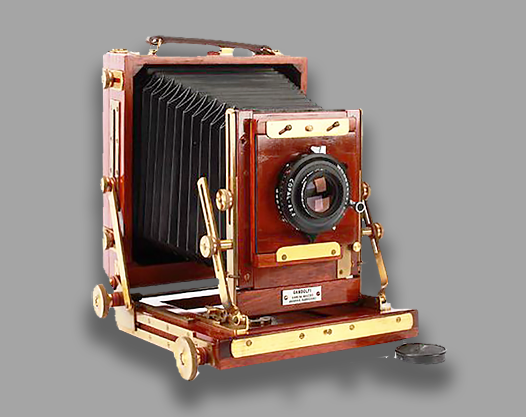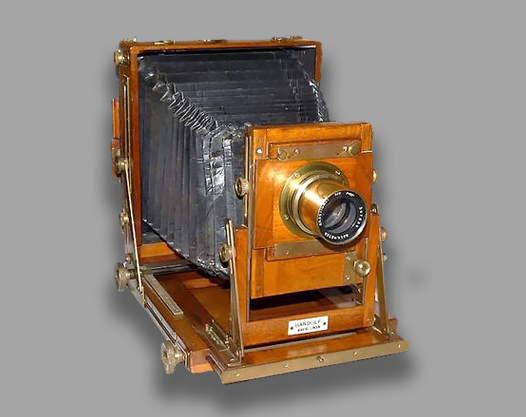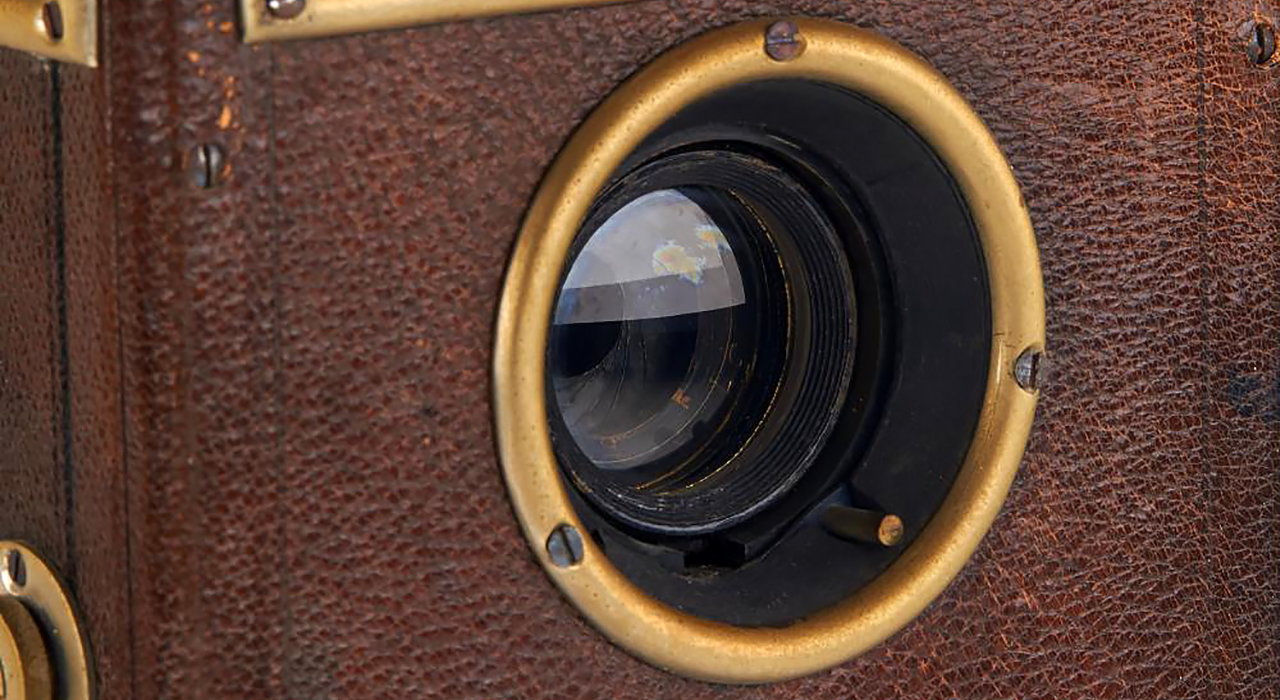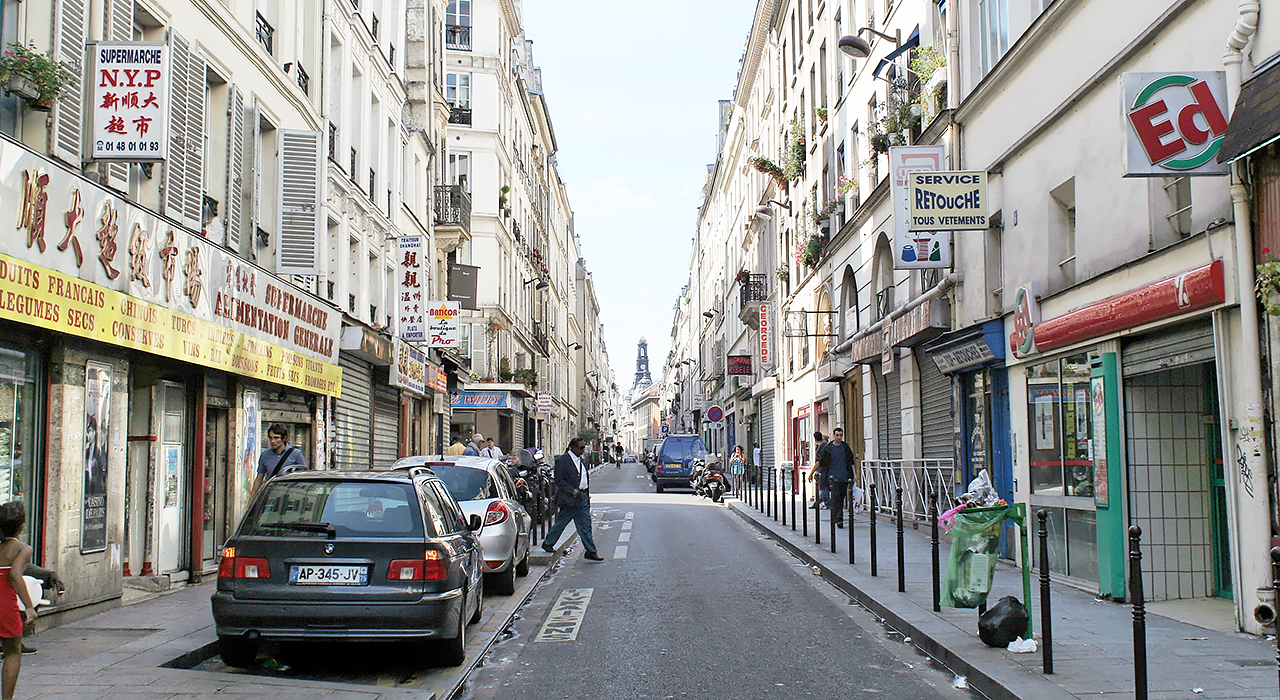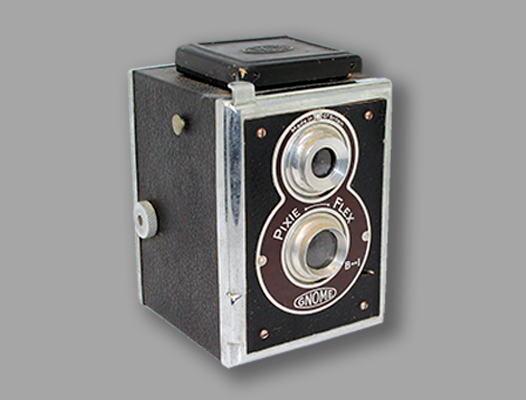Some of the following companies that manufacture(d) photographic material have already passed by in other parts of the site.Here you will find an overview of companies that marketed photographic material in the nineteenth and twentieth centuries.More is usually known about the best known or the most influential companies than about the lesser known ones; therefore they will be discussed more extensively than others.
The emphasis in this part of the site is more on the ups and downs of the company as such, while in other chapters the emphasis was on the product or on the man or woman who founded the company. The order of all companies is alphabetical.
Below are the names of the companies as will be discussed in this or any other chapter. By clicking on a name (so not on the bullet in front of it), you go directly to that part on this page where the manufacturer in question is located. Scrolling is also possible of course, but this service helps you to get to the desired manufacturer in question much faster.
Due to the fact that this introductory page has become much longer than originally planned and desirable due to the large number of manufacturers, we strongly advise you to use the name service below to go to the manufacturer of your choice on this or any subsequent page.
- General Introduction
- ADOX
- Agfa (see also Gevaert)
- Altissa
- Amaloco
- Ansco Camera Co (see also GAF)
- APM/APeM (see also Soho)
Amalgamated Photographic Manufacturers Ltd - Argus Camera Co, Ann Arbor Michigan
- Arsenal (see Kiev-Arsenal)
- Artima Export Ltd (see also Truvox)
- Asahi Pentax
- Bencini
- BOLCo and E Elliott Ltd
(abbrev. for The British Optical Lens Company) - Carl Braun Kamera-Werk
- Canon Inc.
- J.T. Chapman, Manchester
- The Chicago Cluster of Companies
(consisting of 56 companies ) - Chinon
- Concord Camera Corp.
- K.G. Corfield & K.G. Corfield (Sales) Ltd.
- Coronet Camera Company
- Cosina Company, Ltd.
- Dacora
- Dixons
- Durst
- EHO-Altissa company (See Altissa)
- E Elliott Ltd and BOLCo
(abbrev. forThe British Optical Lens Company) - Ellison Kamra
(see also QRS Devry Kamra Company) - ELOP
- Ensign Ltd.
(distribution Company of Houghton-Butcher) - Ernemann-Kamerawerke AG
- Expo Camera Company
- The FED Company
- Ferrania
- Fisher-Price
- Fodor
- Foitzik-Kamerawerke
- C.F. Foth
- Fototecnica
- Franka Kamerawerk –
- Fujica (Camera Division of Fujifilm)
- Fujifilm (brief history)
- Futura
- GAF (see also ANSCO)
(abbrev. for General Aniline & Film) - Louis Gandolfi
- Herbert George Company
- Gevaert Photo-Producten N.V. (see also AGFA)
- Girard et Cie
- GNOME
- GOERZ
- GOMZ (LOMO)
- Graflex (Folmer & Schwing)
- Great Wall Plastics Co
- W. Haking Enterprises Ltd.
- Hanimex
- Hasselblad
- Healthways
- Houghton–Butcher Manufacturing Co (See also Ensign Ltd. and Ross-Ensign Ltd.)
- R.F. Hunter Ltd.
- ICA AG
- Ihagee (Exakta)
- Ilford
- Imperial Camera Corporation
(see the Herbert George Company story) - Jos-Pe
- Kamera-Werkstätten Guthe & Thorsch
- Keystone
- Kiev Arsenal
- KMZ
- Kochmann
- Kodak USA (incl. Australia, Canada, France, Germany & the UK)
- Konica-Minolta (Konishiroku)
(see also Minolta) - Kowa
- Krügener
- Kürbi & Niggeloh (Bilora)
- Kyocera (Yashica, Contax)
- Lancaster
- Leitz
- Lensless Camera Manufacturing Company
- Linhof
- Lipca (see also Richter-Tharandt)
- LOMO (see GOMZ)
- Loreo
- Mamiya
- Meopta Optotechnica
- Mimosa AG
- Minolta (see also Konica-Minolta)
- Minox Company
- Miranda (Orion)
- MMZ-BeLomo
- Motodori (Condor)
- Dr. August Nagel Kamera Werke
- Neidig Kamerawerk
- Nemrod-Metzeler (See Healthways)
- Nettel
- Nikon Company
- Nimslo Corporation (see also Nishika)
- Nishika Optical Systems (see also Nimslo)
- Noblex (See also K-W Guthe & Thorsch)
- Olympus Company
- ORION (see Miranda)
- ORWO
- Ottico Meccanica Italiana (OMI)
- Paterson Products Ltd.
- VEB Pentacon Dresden
- Pentax (See Asahi Pentax)
- Petri
- Photavit (Bolta)
- Plaubel
- Polaroid
- Photo Porst
- Karl Pouva – VEB Fototechnik Freital (see also Woldemar Beier)
- Purma Cameras Ltd.
- QRS Devry Kamra Company (see also Ellison Kamra)
- Foto-Quelle
- Rectaflex
- VEB Rheinmetall Büromaschinenwerk
- Richter-Tharandt (see also Lipca)
- Ricoh
- Rollei Germany
- Rollei Singapore
- Ross-Ensign
(continuation from Ensign Ltd.) - Ro-To Company
- Sea&Sea-Sunpak
- Shanghai Seagull
- Sida-Fotofex
- Sigma
- Soho Ltd (see also APM)
- Standard Cameras
- Steinheil
- Stenopeika
- Thornton-Pickard
- Topcon (Tōkyō Kōgaku)
- Tougodo Company
- Traid Corporation
- TRUVOX (see also Artima Export)
- Tura AG
- Universal Camera Corp.
- Vivitar
- Voigtländer
- Vredeborch
- Welta
- Werra (C. Zeiss Jena)
- Wirgin
- Kamera-Fabrik Woldemar Beier (see also Karl Pouva)
- Hermann Wolf GmbH
- Wünsche
- Yashica (see also Kyocera)
- Zeiss Ikon AG
- Zion
- Zunow (Teikoku Kōgaku)
COMPANY NAMES:
1929: I.G. Chemical Corporation (I.G. Dyes), American arm of I.G. Farben; 1939: General Aniline and Film Corporation after acquiring General Aniline Works and merged with Agfa-Ansco; 1942: General Aniline was seized by the U.S. government; Between 1942 and 1965, General Aniline was managed by government-appointed directors; 1967: GAF becomes the camera brand name adopted by Ansco; 1977: GAF Drops Its Consumer Photographic Lines. 1978: Haking bought the company (and the Ansco brand).
COMPANY ADDRESSES:
1929: ???; 1937: Binghamton, Broome County, New York.
GAF was not a major manufacturer as such, but became the brand used in the US and UK for marketing cameras (including cine cameras) built by other companies to their specifications. GAF bought the View-Master, the famous line of 3D transparencies, viewers and projectors, and continued it under their own brand.
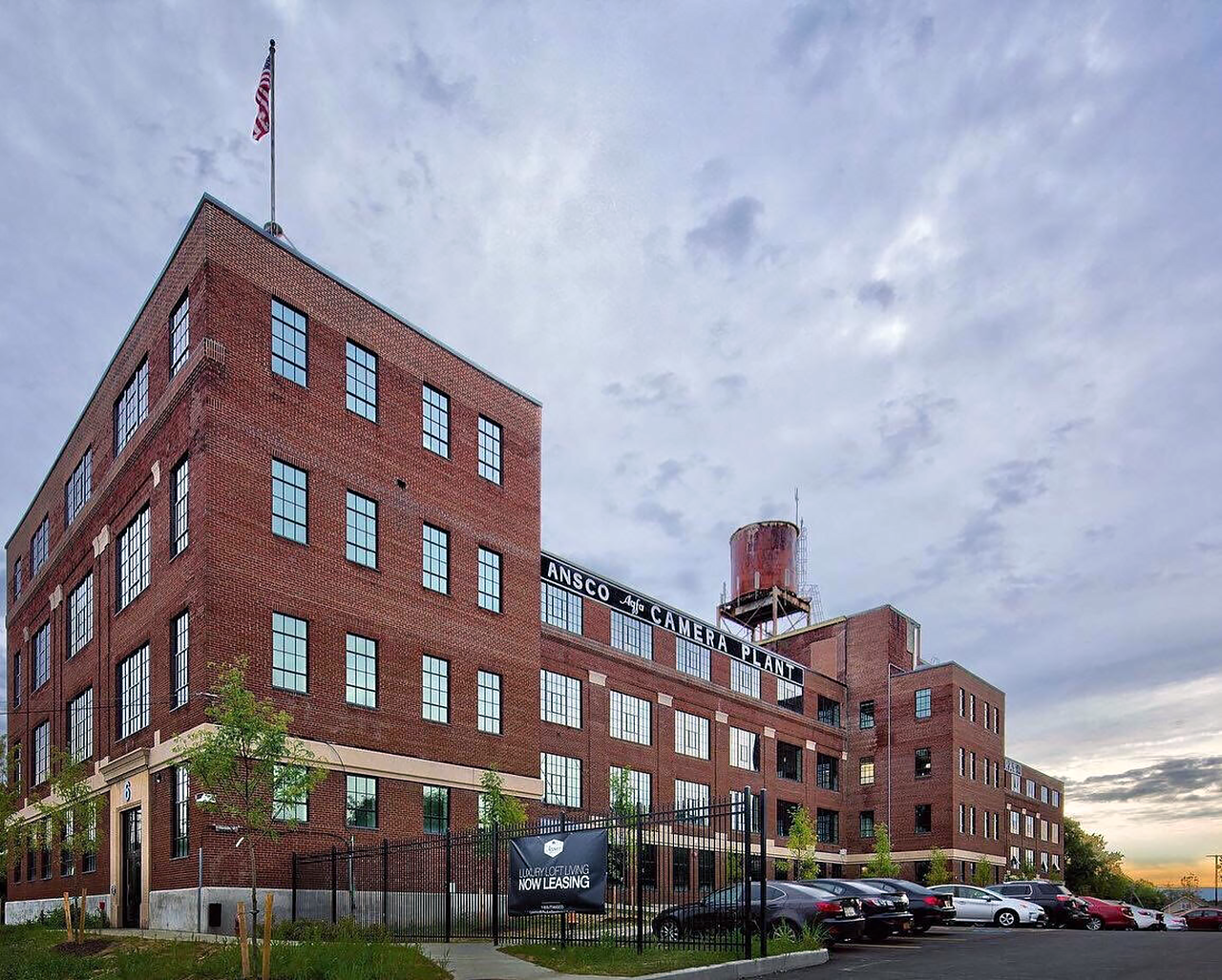
General Cigar Company–Ansco Camera Factory Building, also known as Agfa-Ansco, General Aniline and Film (GAF), and Anitec, is a historic factory complex located at Binghamton, Broome County, New York. It was originally built in 1927-1928 for the General Cigar Company; Ansco purchased the factory in 1937.
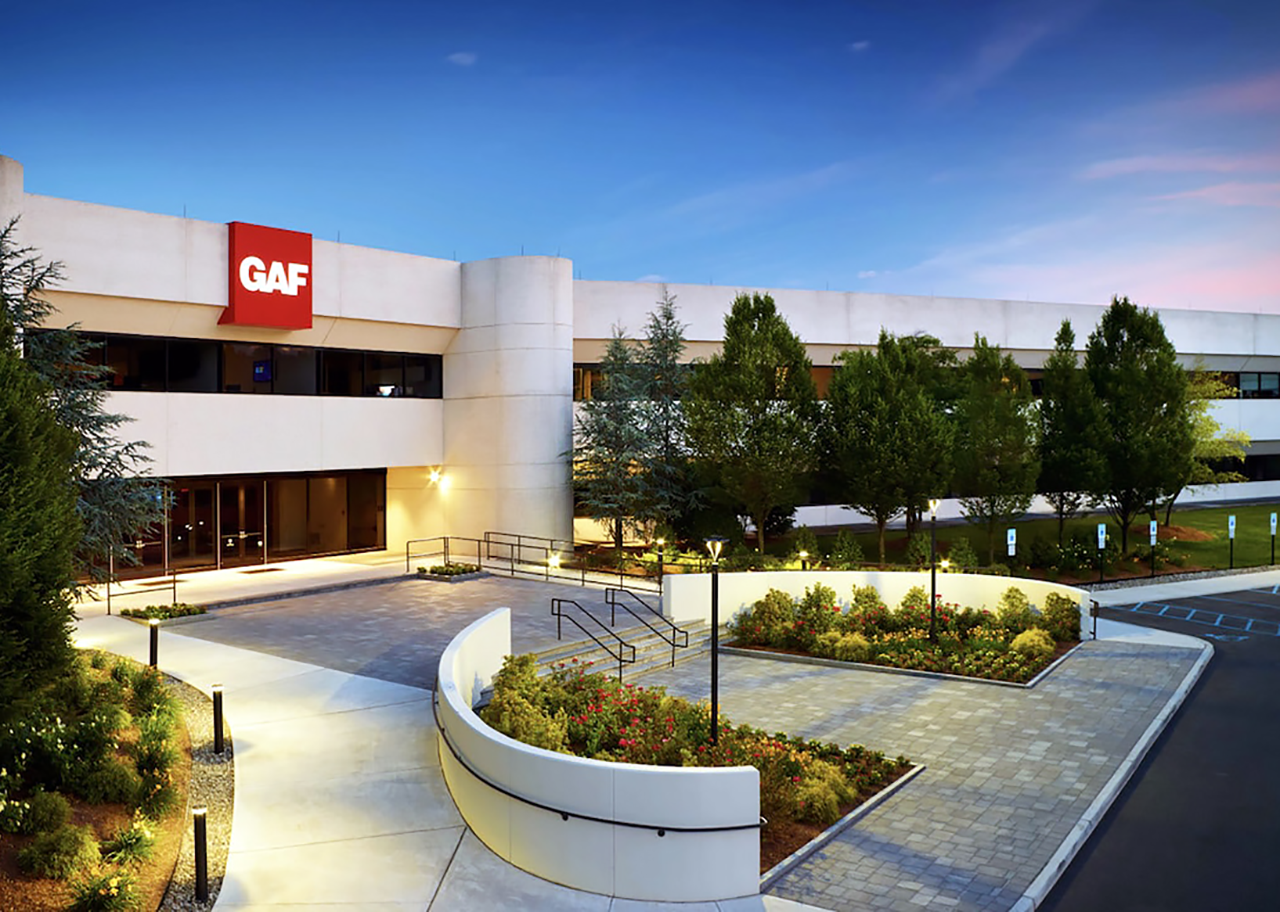
The New GAF Headquarters. The company has historically been primarily focused on manufacturing of roofing materials for residential and commercial applications. At one time GAF was also active in manufacturing photographic film as well as cameras and projectors (both still and motion picture), and was the manufacturer of the View-Master, the famous line of 3D transparencies, viewers and projectors. In 1977 GAF Drops Its Consumer Photographic Lines.
GAF had auspicious beginnings. The company was founded in April 1929, as an American arm of the enormous German chemicals trust, I.G. Farben-industrie. Known throughout the world as I.G. Dyes, the German corporation was involved in most areas of the worldwide chemicals industry, pressing forward with massive investments in research. In 1929 I.G. Dyes was classed as the largest industrial corporation in Europe.
Six executives from I.G. Dyes joined with a handful of prominent American businessmen & among them Edsel Ford, president of the Ford Motor Company; Walter Teagle, president of the Standard Oil Company of New Jersey; Charles Mitchell, chairman of the National City Bank; and Paul Warburg, chairman of the Industrial Acceptance Bank form the board of directors of the American I.G. Chemical Corporation.
For its plant facilities, the new corporation acquired substantial interests in Agfa-Ansco Corporation of upstate New York and General Aniline Works, Inc., which operated in New York and New Jersey. Agfa-Ansco’s roots dated to a photographic supply business, the Edward Anthony Company, set up in New York City in 1842. During the Civil War, Matthew Brady used supplies from Edward Anthony to capture his famous photographs. In the early 20th century, Agfa-Ansco ranked second to Kodak in U.S. production of photographic materials and film.
Changing the name
 In 1939 the company changed its name to the General Aniline and Film Corporation, after having acquired all of General Aniline Works and merged with Agfa-Ansco, of whose stock it owned 81 percent. By that time it had received approximately 3,900 patents for its vast stock of chemical formulations.
In 1939 the company changed its name to the General Aniline and Film Corporation, after having acquired all of General Aniline Works and merged with Agfa-Ansco, of whose stock it owned 81 percent. By that time it had received approximately 3,900 patents for its vast stock of chemical formulations.
From the beginning, General Aniline was designed to be largely controlled by and dependent upon German direction and research. Almost all of its research took place in Germany, and chemical intermediates were manufactured in that country and sent to U.S. plants only for final preparation.
The company’s consistent success was earned through a steady performance in the fields of dyes, chemicals, and photographic products. In fact, General Aniline was the leading U.S. manufacturer of dyestuffs until du Pont caught up in the late 1930s. An acquisition that had an impact on the company’s future was that of the Ozalid Corporation, a producer of copying equipment, in 1940.
General Aniline and Film survived some early criticisms of its very existence by Americans who questioned the prudence of such a large German concern operating in the United States. The company’s record was legitimate, but the direct participation in its management by German citizens had raised some cautious eyebrows on Wall Street and in Washington.
Under governmental leadership
Soon after it became apparent that the United States would be an active participant in World War II, General Aniline was seized by the U.S. government in February 1942, under the Trading with the Enemy Act. It was the largest asset taken over by the United States in World War II.
This move developed into a longstanding legal dispute between the U.S. government and I.G. Chemie, a Swiss holding company that was the majority stockholder of General Aniline. Prior to 1940 I.G. Chemie had been a branch of I.G. Dyes, but the company contended that it broke all relations with Germany during that year, becoming an independent corporation called Interhandel. The U.S. view was that I.G. Chemie remained a front for I.G. Dyes, despite its claims to the contrary. An out-of-court settlement between the Justice Department and Interhandel was finally reached over 20 years later – General Aniline would be sold to the public, and proceeds from the sale would be split 60 percent/40 percent, with the United States receiving the majority share.
Between 1942 and 1965, General Aniline was managed by government-appointed directors. It was a turbulent, minimally profitable time for the company. All told, during this period the company had seven different chief executives and over 80 directors. In several regards the government’s hands were tied, preventing it from acting as freely and spontaneously as most managers could during this period.
Long-term planning was impossible
The rapid turnover of directors in itself created a barrier to long-term planning. The directors were excessively cautious, in most cases focusing on immediate rather than long-term results, never knowing when the company would be sold to the public.
The pending lawsuit with Interhandel created an atmosphere resistant to risk-taking, as each potential move by General Aniline was accompanied by threats of further legal action by Interhandel.
For instance, one injunction, obtained by Interhandel in 1957 in order to prevent dilution of General Aniline’s equity, prohibited the company from issuing its shares for acquisitions or from entering the equity and capital markets for money with which to expand. As board president Jack Frye stated in 1953, “One of the problems of this company is that, due to its ownership situation, the management, the boards of directors, and all concerned are extremely cautious about making expenditures. In trying to avoid mistakes, they actually move more slowly than do their competitors.”
Because of these restrictions, General Aniline’s growth was stagnant compared to competitors in the same industries. In film and photographic equipment, the company competed chiefly with Kodak, in chemicals with du Pont, and in copying equipment with Xerox. All these firms, indeed each of the industries in question, experienced unprecedented growth and diversification through the postwar period and into the 1970s.
GAF-Cameras
Some GAF cameras were also branded Anscomatic. GAF was also the corporate owner of Lenco Photo Products, Inc., a company that distributed photographic gear under the brand name of Lentar.
GAF sold several 35mm SLRs, rangefinders and viewfinder cameras. The SLRs and rangefinders were made by Chinon or Cosina, and were functionally the same as Chinon models. Other formats may have been made by Petri, but the cheapest models typically came from Haking in Hong Kong. Haking finally bought the company (and the Ansco brand) in 1978.
- GAF L-14 – Rebranded Chinon M-1 sold with an f/1.4 standard lens
- GAF L-17 – Rebranded Chinon M-1 sold with an f/1.7 standard lens
- GAF L-CM
- GAF L-CS – Rebranded Chinon CS
- GAF L-CX – Rebranded Chinon CX
- GAF L-ES
- GAF L-ES a
- GAF L-ES/2 – Rebranded Chinon CE II Memotron
- GAF Ansco Autoset CdS
- GAF Memo 35 EE (a clone of the Vivitar 35ES and also rebranded by Dixons in the UK as the Prinz 35EE, with all of them being based on the Konica 35 and Minolta Hi-Matic rangefinders.)
- GAF Memo 35 ET (similar to 35 EE, but with the slower f/2.8 lens, making it comparable to the Vivitar 35EE and Chinon 35EE)
- GAF Point Five (by Chinon)
- GAF Ansco Memo II (rebadged Ricoh Auto Half)
GAF-branded 126 film cameras
- GAF 100 XF
- GAF 136 XF (126, cartridge camera, clone of Halina Signal Flash).
- GAF 200 XF
- GAF Anscomatic 126
- GAF Anscomatic 326
- GAF Anscomatic 626
- GAF Anscomatic 726 (a rebadged Petri rangefinder)
- GAF Anscomatic Cadet
- Anscomatic Cadet Flash
- GAF Seventy Six instant load
GAF-branded 110 film cameras
- GAF 220 Instant Load
- GAF Personal Camera
- GAF Personal 2
GAF-branded 127 film cameras
- GAF Ansco 127
The Ansco Memo II Automatic is a 35mm half-frame camera introduced in 1967 by Ansco. The Memo II Automatic and the Ansco Memo Automatic from 1963 are actually the same exact camera, just re-released to reflect the name change from Ansco to General Aniline & Film (GAF). In turn, both cameras are rebadged versions of the Ricoh Auto Half and were manufactured by Ricoh for sale by Ansco. The Memo Automatic from 1963 is not to be confused with the original Ansco Memo, a 35mm half-frame box camera from 1927.
The GAF Anscomatic 126 is a response to the runaway success of the Kodak Instamatic series. It is a simple fixed focus snapshot camera using drop-in 126 film cassettes. The top of the camera has a socket for flashcubes that came in many varieties and intensities depending on distance needed for the photo. In 1967 you could buy the camera for $15.00 or for three more dollars you had the complete outfit and it came with a one year unconditional guarantee. It is a good looking, easy to use, reliable, inexpensive camera.
The curiously alien-looking GAF Ansco 127 was produced after a 1967 adoption of the GAF trademark to supersede Ansco as the company’s camera brand.
The GAF Ansco 127 starts from some of the styling motifs of the Ansco Cadet II and makes them even more flamboyant Likewise, film is still advanced using a large knob on the bottom of the camera. Each roll yields 12 images 4×4 cm square. The lens is fixed focus.
In 1966, Sawyer’s was acquired by the GAF Corporation, and became a wholly owned subsidiary. Under GAF’s ownership, View-Master reels began to feature fewer scenic and more child-friendly subjects, such as toys and cartoons. Television series were featured on View-Master reels, such as Doctor Who (sold only in the U.K.), Rowan & Martin’s Laugh-In, Star Trek, The Man from U.N.C.L.E., Family Affair, Here’s Lucy, and The Beverly Hillbillies. Actor Henry Fonda appeared in a series of TV commercials for the GAF View-Master.
FOUNDER: Louis Gandolfi
COMPANY NAMES:
1885: : Louis Gandolfi; 1932: Louis Gandolfi & Sons.
COMPANY ADRESSES:
1885: 15A Kensington Place, Westminster; 1913: 752 Old Kent Rd., London; 1913: 84 Hall Road, Peckham Rye, South London; 1928: 2 Borland Road Peckham; 1982: Andover, Hampshire.
Gandolfi was a British manufacturer based in London, a company which have made large format cameras in the traditional style using wood and brass for many years. In the early twenty-first century they have begun making more modern versions, still large format but using newer materials and techniques, although the traditional cameras were still made as well. Finally, the company was closed on the 13 October 2017 by Edward Hill.
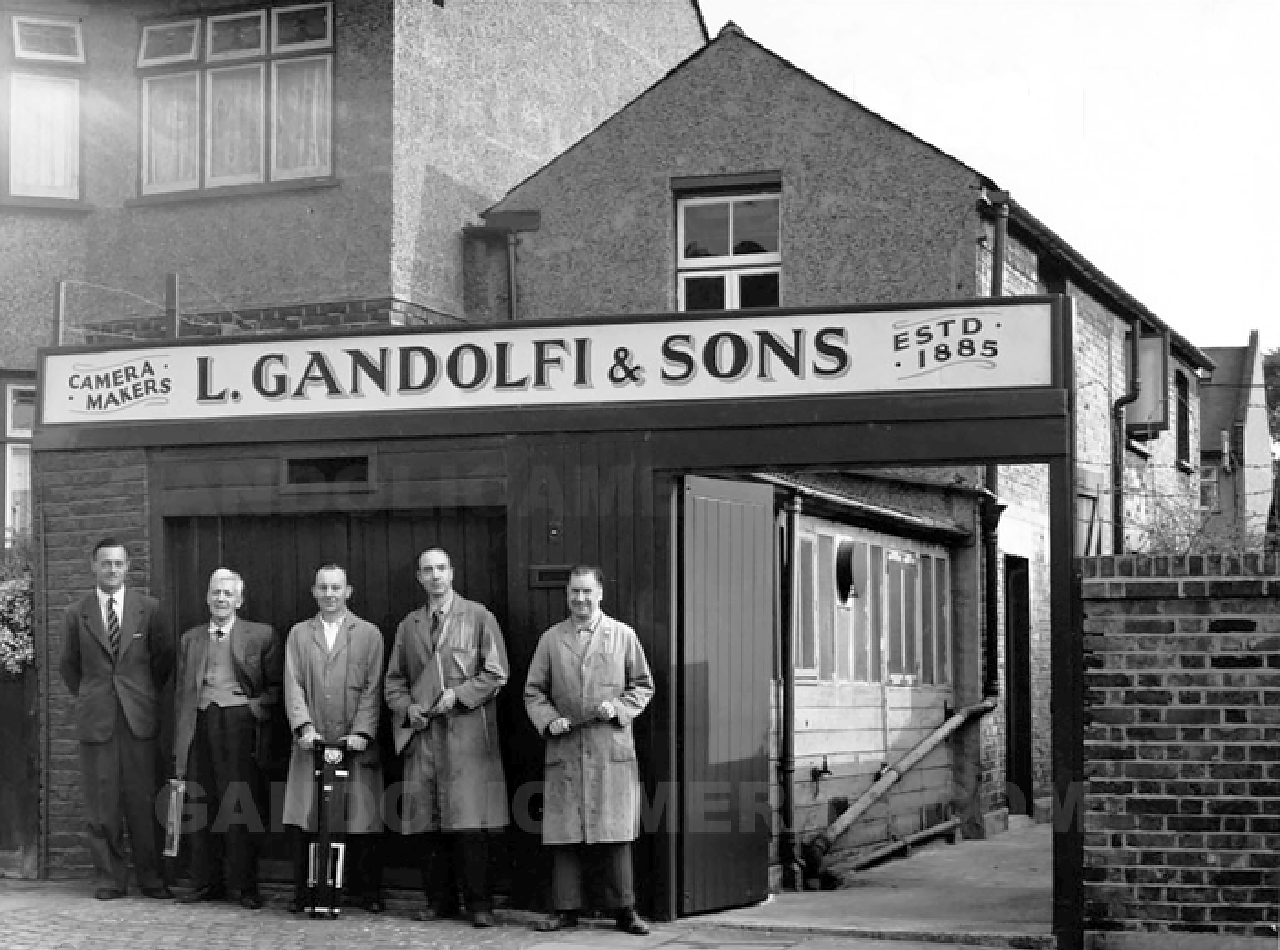
A photo of the Gandolfi company with the entire staff in front of the entrance. The photo must definitely have been taken after 1932, because the name on the sign above the entrance already indicates Louis Gandolfi & Sons.
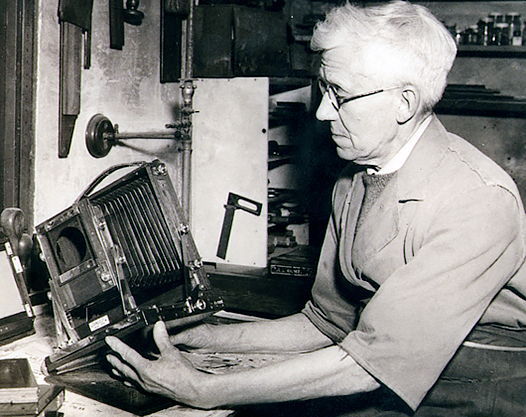
Thomas Gandolfi in the workshop.
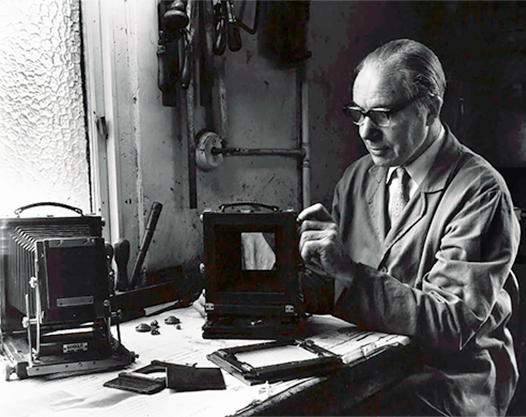
Frederick Gandolfi in the workshop.
In 1876 at the age of twelve Louis Gandolfi started work as an apprentice cabinet maker. His apprenticeship lasted four years. He then embarked on a career as a camera maker at Lejeune Perkins and Company, of Hatton Garden, London, where he excelled for five years, to the point where his fellow workers complained that he worked too fast and too accurately, thereby earning too much money from the piecework system. He was forced to move on and in 1885 Louis Gandolfi established his own camera maker business at 15A Kensington Place, Westminster. It was a family business, since he was only assisted by his wife Caroline, who learned the skills of French polishing and brass work lacquering.
In 1890 his first son Thomas Joseph was born, followed by Frederick Louis in 1904, and Arthur Ernest in 1907. The Gandoli’s also had three girls but not much information was available on their births, however it was recorded that the Gandoli’s had six children and all the boys and two of the girls worked the family business.
Shortly after the the turn of the century, Louis gained Colonial Office contracts to supply cameras for the harsh climates of India and the Federated Malay States. He redesigned his cameras and incorporated new patents for a highest quality camera called the Imperial.
In 1913 the business was moved to Hall Road, Peckham Rye, South London. The Gandolfi family lived at the Old Kent Rd premises and later at the Hall Rd address.
The Gandolfi Sons enter the company
The Gandolfi’s business survived the 1920s recessions and by 1928 the business was moved again to an old Victorian Hatpin factory at 2 Borland Road Peckham. At this time Thomas, having completed service in the Great War, devoted himself to cabinetmaking, Frederick took over business operations and Arthur after leaving the family business during the 1920s to learn clerical work, returned to fill the job of assembly and finishing.
With the help of his sons running the business and especially the matching craftsmanship achieved by his son Thomas, Louis began to accept commissions to make custom built Gandolfi cameras. Among the first customers was the famous photographer Herbert Ponting, who accompanied Captain Scott on his fatal Antarctic expedition, and for the Earl of Carnarvon for the Tutankhamun expedition.
Louis constructed some of the earliest “Big Bertha” telephoto cameras, that captured cricket matches, horse races and earliest British atomic explosion. Three years later, The Gandolfi’s supplied the first aerial cameras to the Royal Naval Air Service.
In 1928 Louis handed over the company to his sons, Arthur Ernest born 1907, Frederick Louis, born 1905 and Thomas Joseph, born 1890, who continued to run the company in the traditional way. They never employed more than a few staff, and were a small craftsman-type operation.
In 1932 with the comfort of knowing that his three sons were running the business, Louis Gandolfi died at the age of 68. At his death the effects of Louis Gandolfi amounted to the considerable sum of £1505. With his passing the business name was changed to Gandolfi & Sons and the business continued to prosper.
Refusing a large contract
During the second world war Gandolfi & Sons supplied portrait cameras and tripods to the Admiralty, Air Ministry and War Department. However, they missed out on a substantial opportunity for a government contract to supply 1,000 cameras, because they realized that they could not fulfill such a large contract, and it went to their competitor Watson & Sons. After the war they saw a boom for prison mug shots and supplied over 39 prisons and police authorities with specialized equipment.
In 1965, Thomas Gandolfi died leaving the business to his two brothers Arthur and Fredrick.
In the early 1970s the the 5 x 4 inch format “Precision” camera was supplied in great qualities to educational and scientific institutions. The Gandolfi camera became so popular with graduating students that the demand grew to the point of the company recording waiting lists that would extend for over a year. This waiting list continued until in 1976, Thomas Gandolfi’s son Tom junior was persuaded to join the firm by taking an early retirement from engineering and helping with alleviating the backlog.
The final years
In 1982, Arthur and Fred realized that they could not continue to run the business by them selves, however they wanted to continue the business to make the 100-year mark. They were able to negotiate a comprise sale with with Brian Gould and his partner Sir Kenneth Corfield, where the last Gandolfi apprentice Fredrick would sign a satisfaction certificate. With this sale, the company moved to new premises in Andover, Hampshire, and The Gandolfi camera maker reached its 100-year mark. Fredrick died in his own home in 1990, and the last of the Gandolfi brothers Arthur died on 22 January 1993 at the age of 90.
The Gandolfi company was sold a few years previously, when the brothers retired, but still continued to make cameras, both the traditional mahogany and brass models and the new Variant models. The company was closed on the 13 October 2017 by Edward Hill.
Gandolfi Camera Listing
Probably due to the fact that Gandolfi rarely made her cameras in series, there are several lists of camera types on the internet. Below are the lists as provided by Historiccameras and Collectiblend. There are some similarities but there are more differences. In addition, Collectiblend also lists cameras made in later years.
Compactum
Collapsible
Special
Imperial
Imperial Improved
Premier
Precision
Universal
Universal Deluxe Hand Camera
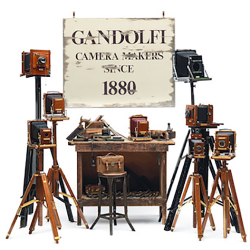
| Field Camera | c1890-1900s |
| Hand and Stand Camera | c1890-1900s |
| Portrait Camera | c1890s |
| Prison Camera | c1890s |
| Tailboard Camera | c1898-1920 |
| Universal | c1898-1920 |
| Universal Stereo | c1900s |
| Universal (folding, 3×4) | 1912 |
| Universal (folding, 4×5) | 1912 |
| Universal (folding, 9×12) | 1912 |
| Stereo | c1920 |
| Stereo Tropical | c1920 |
| Precision | c1970s |
| Studio Camera | c1970s |
| Tourist Camera | c1974 |
| Iriant | c1994 |
| Variant I | c1994 |
| Variant II | c1994 |
| Variant III | c1994 |
1945: Herbert George Company; 1961: Imperial Camera Corporation.
1945: Chicago, Illinois.
Herbert George is probably best known for its production of inexpensive solid bakelite and plastic all-in-one box cameras featuring built-in flash and view finders. They sold them under their own brands as well as on behalf of other companies and organizations including the Walt Disney Company, the Roy Rogers Show, the Boy Scouts of America, and the Girl Scouts of the USA.
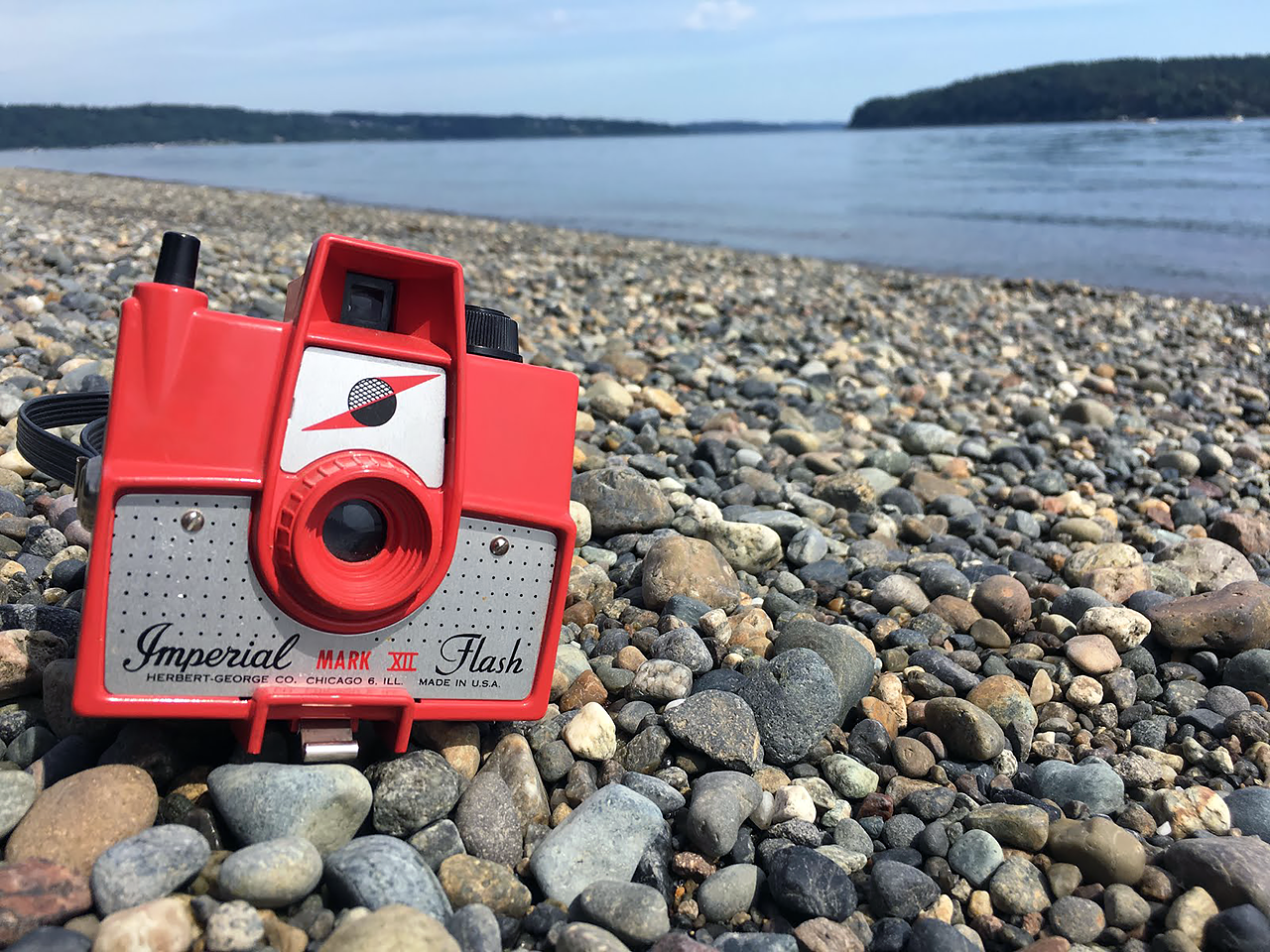
An artist’s impression of the Imperial Mark XII Flash, which was manufactured in many bright colours.
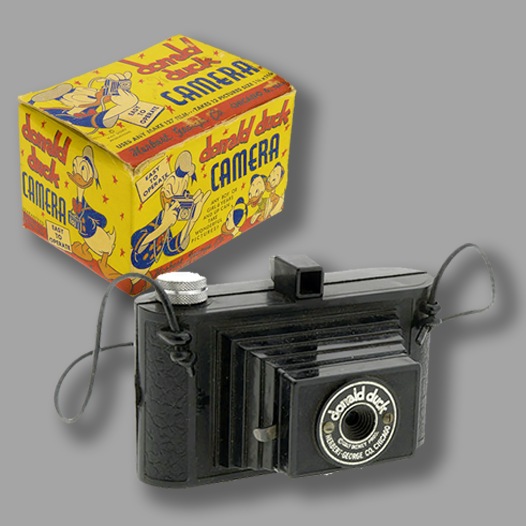
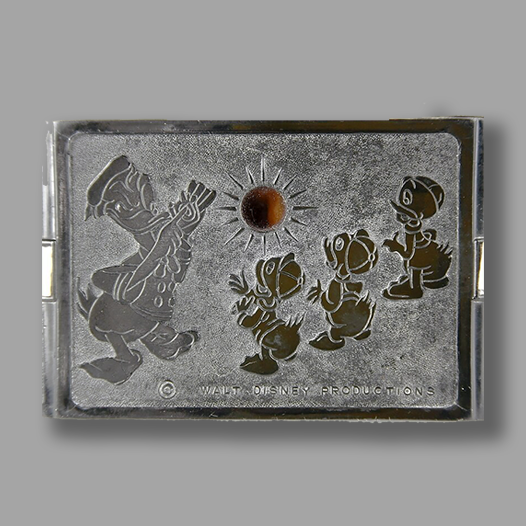
Donald Duck Camera in Box (Herbert George Company, 1946). The Herbert George Company produced this delightful Donald Duck film camera in 1946. The front of the camera reads, “Donald Duck, Walt Disney Productions, Herbert-George Co., Chicago”. On the back of the camera is an image of Donald Duck shooting a photo of his nephews.
Around the mid-century, there were a lot of camera manufacturers that set up shop around Chicago. This one, the Herbert George Company, made many different promotional character cameras. It was founded in Chicago, Illinois by Herbert Weil and George Israel in 1945. The company name came from the founders Herbert Weil and George Israel. It was one of the first companies to offer a series of cameras with multiple eye-catching colours and styles to spur sales of what were otherwise very basic designs.
After its establishment at the end of World War II, the Herbert George Co. manufactured its first camera: the Donald Duck, an officially licensed Disney product featuring the likeness of Donald Duck with his nephews Huey, Louie, and Dewey on the back. The company also produced a non-Disney version of the Donald Duck camera, choosing instead to create its own in-house brand. Imperial was the main camera brand but Herco appeared on some models, such as the Herco Imperial; then Imperial won out as the preferred name. The Herbert George Co. used the Herco name for a number of different box and pseudo-TLR cameras until the mid 1950s when they began releasing cameras under the Imperial brand as well. The Imperial and Herco brand names proved to be popular.
In the 1950s, the Herbert George Company of Chicago, Illinois produced an official Girl Scout camera. Many Boy Scout cameras were produced throughout the mid-1900s, but few models were made for the female scouts. This easy-use 620 box style camera used an eye-level viewfinder and featured the Girl Scout logo on its faceplate.
The company was sold to new owners in 1961 who changed its name to the Imperial Camera Corporation before shuttering it for good. The change of corporate name did not change the creed of the company which was to manufacture simple and popular cameras. The cameras are made of plastic, of a very limited handling. The colours are often enough sharp compared with those of the remainder of the production photographs (it seems Tupperware).
The Imperial Savoy was one of the first 6 x 6 cameras they produced under the new name. It was one of the most widely-sold models between 1956 and 1965. This simple box camera uses 620 films, giving twelve images 6x6cm square per roll. 620 film is pretty much identical to 120 films with the exception that the spool it’s wound around has thinner ends, making the roll of film shorter. The lens is a fixed focus and there are no exposure adjustments. Numerous colour variants are known, including black, beige, mint green, grey, and light blue.
From 1961, the Herbert George company gave way to Imperial. The devices produced by the new brand are a continuation of those of Herbert George. If the patent application dates are to be believed, Imperial remained active until the early 1980s, but increasingly producing in Asia. Patents filed by Imperial Camera Corp. bear the name of inventor that of George Irwin, who was already working for Herbert George in the second half of the 1950s.
Cameras in alphabetical order as made during the Herbert George period and the Imperial period:
- 620 Cub Scouts
- 620 Girl Scouts
- Adventurer 620
- Cubex IV
- Cubex IV – Boy Scouts of America
- Donald Duck
- Fredella
- Herco Imperial 620
- Herco-Flex
- Imperial 127 Reflex Flash
- Imperial Cinex
- Imperial Debonair
- Imperial Debonair Cub Scouts
- Imperial Delta
- Imperial Deluxe Twin Lens Reflex
- Imperial Lark
- Imperial Mark 27
- Imperial Mark XII
- Imperial Mark XII Boy Scouts
- Imperial Mark XII Girl Scouts
- Imperial Six-Twenty
- Imperial Reflex 620
- Imperial Satellite 127
- Insta-cube 126
- Insta-Flash
- Insta-Flex
- Instatant Load 900
- Mark II Savoy
- Official 3-Way Camera – Boys scouts
- Official Camera Boy Scouts of America 127
- Official Camera Girl Scouts of America 127
- Rambler
- Roy Rogers and trigger 620
- Sabre 620
- Savoy
- Stylex
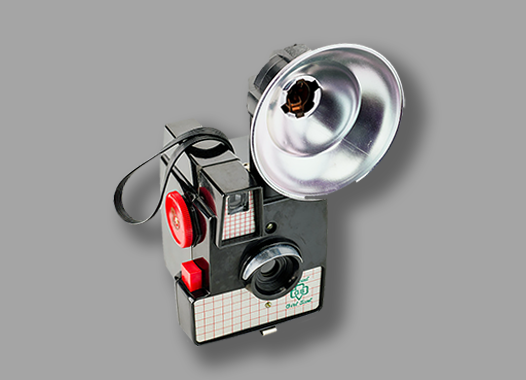
Herbert-George Company Official Girl Scout Camera with attached flash assembly. The medium format camera has a black and red plastic body with two small grey metal panels attached to the front printed with a red grid. The camera used 620 size film. The camera is very similar to the Herbert George Company’s Imperial Debonair model, produced from the early 1950s to 1961.
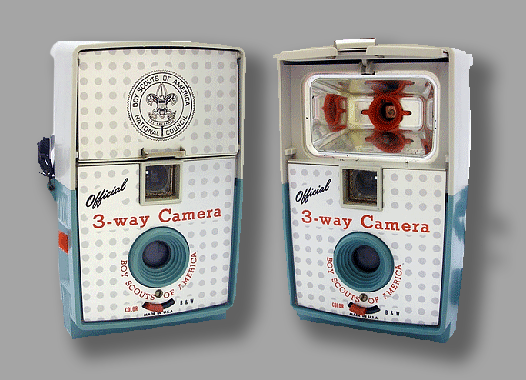
The Offical 3-Way Boy Scouts Camera was originally manufactured in the 1950s. This was the same camera as the Mark 27, except it carry different styling and the Boys Scout logo on the flip up flash cover. It was capable of capturing 2 X 2 inch color slides, kodacolor or B&W pictures on number 127 roll film. It used the small No. AG-1 flash bulbs sometimes called “jelly bean” bulbs.
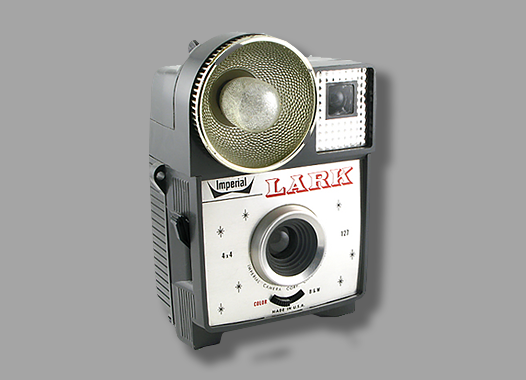
The Lark is a 1960s plastic camera from Imperial of Chicago, Illinois. It appears to be a revision of the Imperial Mark 27 but with a restyled top housing which includes a “bug eye” flash reflector for flashbulbs. It exposes images 4×4 cm square onto 127 film, advanced with a knob on the camera bottom.
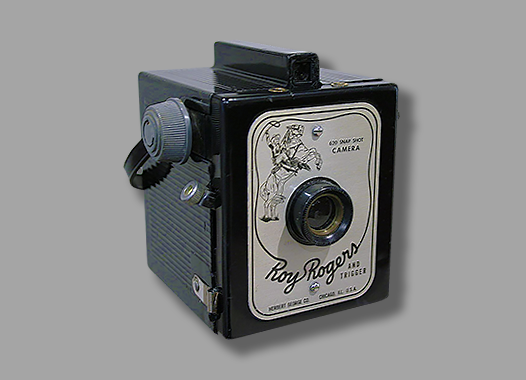
The Roy Rogers and trigger 620 snap Shot Camera was made in circa 1950. It was an simple box camera made of bakelite with a decorative metal faceplate depicting the famous television personality Roy Rogers and his trusted horse Trigger. It featured a built-in eye-level view finder, a removable synchronized flash unit, a simple fixed focus meniscus lens and a simple snap shot shutter. It was capable of capturing twelve exposures, 2 1/4 x 2 1/4 inch in size, on 620 colour or black and white roll film.
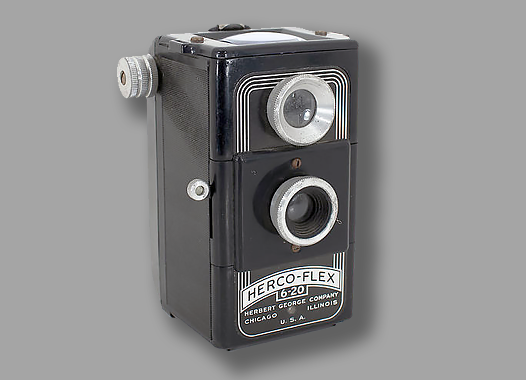
The Herco-Flex 6-20 Camera is a simple pseudo-TLR and was manufactured in circa 1950. This twin lens style camera was constructed of plastic. It featured a full size top mounted view finder. It was capable of capturing 2 1/4 x 2 1/4 inch sized exposures on number 620 roll film. The example pictured here may seem to lack a cover or surround for its finder. In fact, this is how the camera was sold.
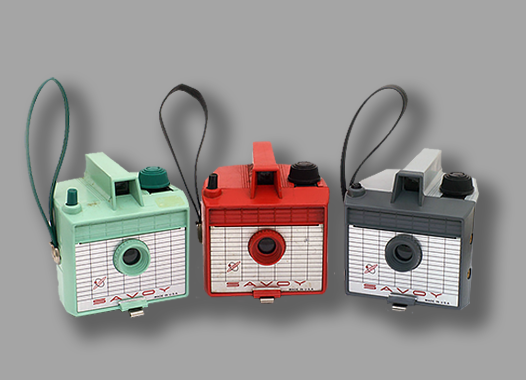
The Savoy Snap Shot Camera was originally made by the Herbert George Company of Chicago Illinois in circa 1950. It was continued when Imperial Camera corp took over the business with a slightly different design style. It was a simple box camera constructed of plastic. It featured a built-in eye-level view finder, a fixed focus lens and a simple snap shot shutter. It was capable of capturing twelve exposures on number 620 color or black and white roll film. It was made in various colours including black, grey and lime green.
FOUNDER: Lieven Gevaert
COMPANY NAMES:
1894: Lieven Gevaert & Cie; 1920: NV Gevaert Photo-Producten; 1964: Gevaert Photo Producten; 1964: Gevaert-Agfa N.V.; 1971: Agfa-Gevaert N.V.
COMPANY ADDRESSES:
1890: Montignystraat, Antwerp; 1892: Heilig-Kruisstraat, Mortsel; 1904: Septestraat 27, Mortsel.
Gevaert and later Agfa-Gevaert were of great importance to Belgian industry. The company excelled for decades in the (scientific and commercial) development and democratization of photographic products and processes.
In addition, Gevaert was a leader in the field of innovative business operations and modern personnel policy. For example, labour leave was introduced and a factory council was established – no fewer than four decades before the Belgian government made works councils a legal requirement in 1948. Gevaert was also a pioneer with regard to profit participation by the staff: employees could participate in the company’s profit from as early as 1904.
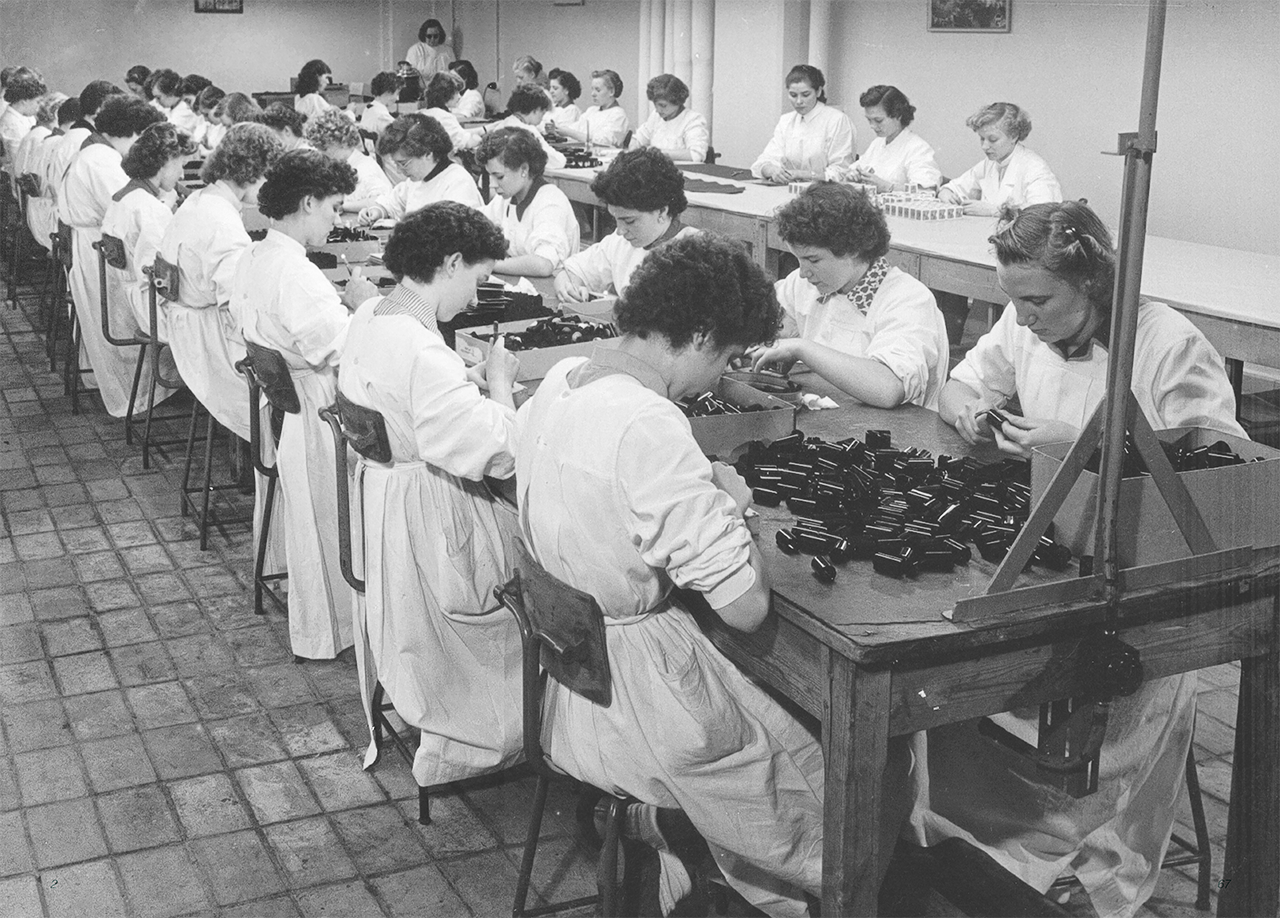
A photo from the PDF-File “I worked at Gevaert” showing the department where dozens of girls packaged the films.
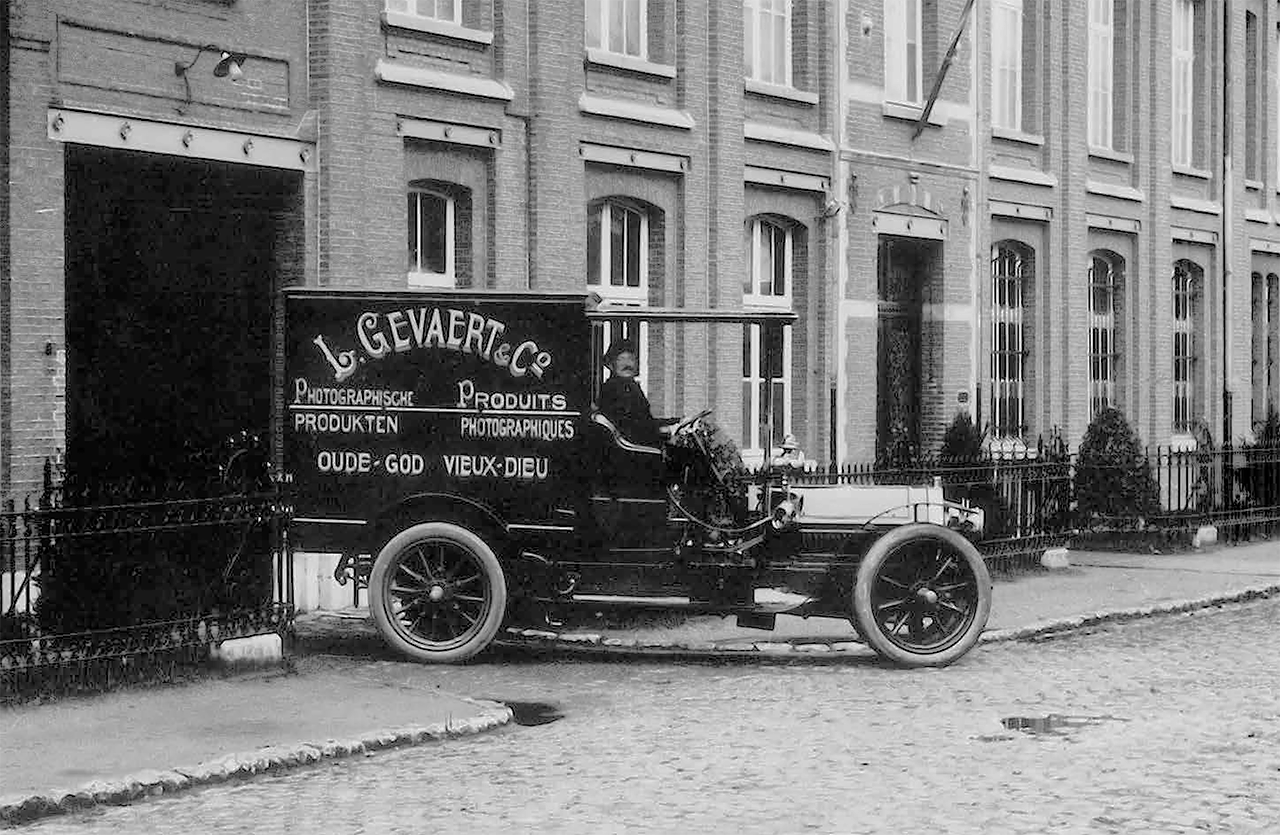
The person who did work at Gevaert and remembered the preparations for the king’s visit was Edmond Vanroey, who was hired as a driver at the time, including for the trade directors during Expo 58: “When they knew the king would come by, I had to drive through the factory by car. There was someone in the back who looked out and saw how high the king would look. A line was drawn on that line, and everything below it – what the king would see – was repainted. Not anything above that line.” (A story from the PDF-File “I worked at Gevaert”)
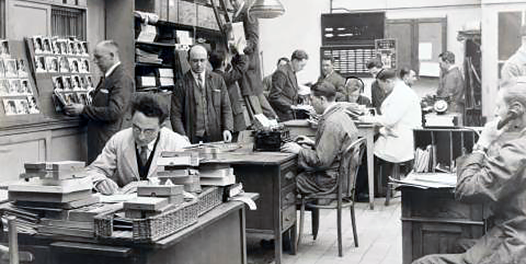
The ‘Photocontrol’ department was charged with the inspection of the manufactured photographic paper, 1927
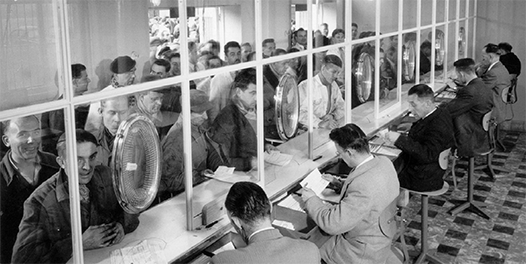
At the time, wages were still paid in a pay packet, which you had to sign for receipt.
 In 1890, the twenty-two-year-old photographer Lieven Gevaert (1868-1935) opened a photography business in Antwerp with his mother.
In 1890, the twenty-two-year-old photographer Lieven Gevaert (1868-1935) opened a photography business in Antwerp with his mother.
Gevaert soon realized how dependent he was on imports from abroad for his (expensive) photographic paper. So he decided to make it himself from now on. In 1894 the result – calcium paper – came onto the market and Gevaert was renamed the limited partnership Lieven Gevaert & Cie.
The success of Gevaert’s photographic paper was enormous: (amateur) photographers came to him en masse for their supplies, even though the competition in Belgium was actually very strong. In contrast to its competitors, Gevaert had rightly gambled on photo paper instead of photo plates as material for the future.
Photographic paper offered numerous advantages: it was no longer produced manually, the shelf life of the products was guaranteed, the necessary equipment for the photographer was simple and sales could take place via a distribution network. Thanks to this success, Gevaert was able to have a completely new factory built in Mortsel in 1904-1905 and to strengthen its leading position.
The demand for Gevaert’s photographic paper was also high abroad, so that the company was able to open branches there. Along with the success, the number of innovative paper types and new products grew.
After the First World War, the company continued to expand spectacularly: in 1920, the subsidiary Gevaert Company of America saw the light of day and the company was transformed into NV Gevaert Photo-Producten.
After the survival period entailed by the Second World War, the 1950s were mainly dominated by automation and broadening of the target group: the company now also focused on the craftsman and the professional sector, such as medical organisations.
Because the competition with international players such as Kodak, Agfa, Fuji and Ilford was fierce, Gevaert was also intensely involved in marketing and corporate identity from that decade onwards, with a focus on the foreign market.
Gevaert had its absolute peak in 1964. In that year the merger with Agfa AG took place. It immediately marked the end of what had been a purely Belgian history until then. Initially Gevaert-Agfa and from 1971 called Agfa-Gevaert, the company was fifty percent owned by the Gevaert holding company and fifty percent by Bayer.
In 1981, Bayer became the sole shareholder of Agfa-Gevaert by buying out Gevaert. Since the 1980s and 1990s, Agfa-Gevaert has focused on digitization and image processing in the graphic and healthcare industry.
Currently (2012), Agfa-Gevaert (Belgium) is still producing industrial film for the medical, semiconductor and graphic press industry. A couple of companies like Maco using the Rollei brand and Fotoimpex using the Adox brand continued production on some of the film and paper products. In Japan, Powershovel has licensed the AgfaPhoto brand for Vista print and CT Precisa slide film. The films are sold and manufactured in Japan.
In 2015, Agfa-Gevaert had sales of EUR 2.65 billion and a net profit of EUR 71 million. Today, about three thousand people still work at the site in Mortsel.
Here we place a number of photos that will certainly provide many memories for the people of Gevaert and the residents of Mortsel.
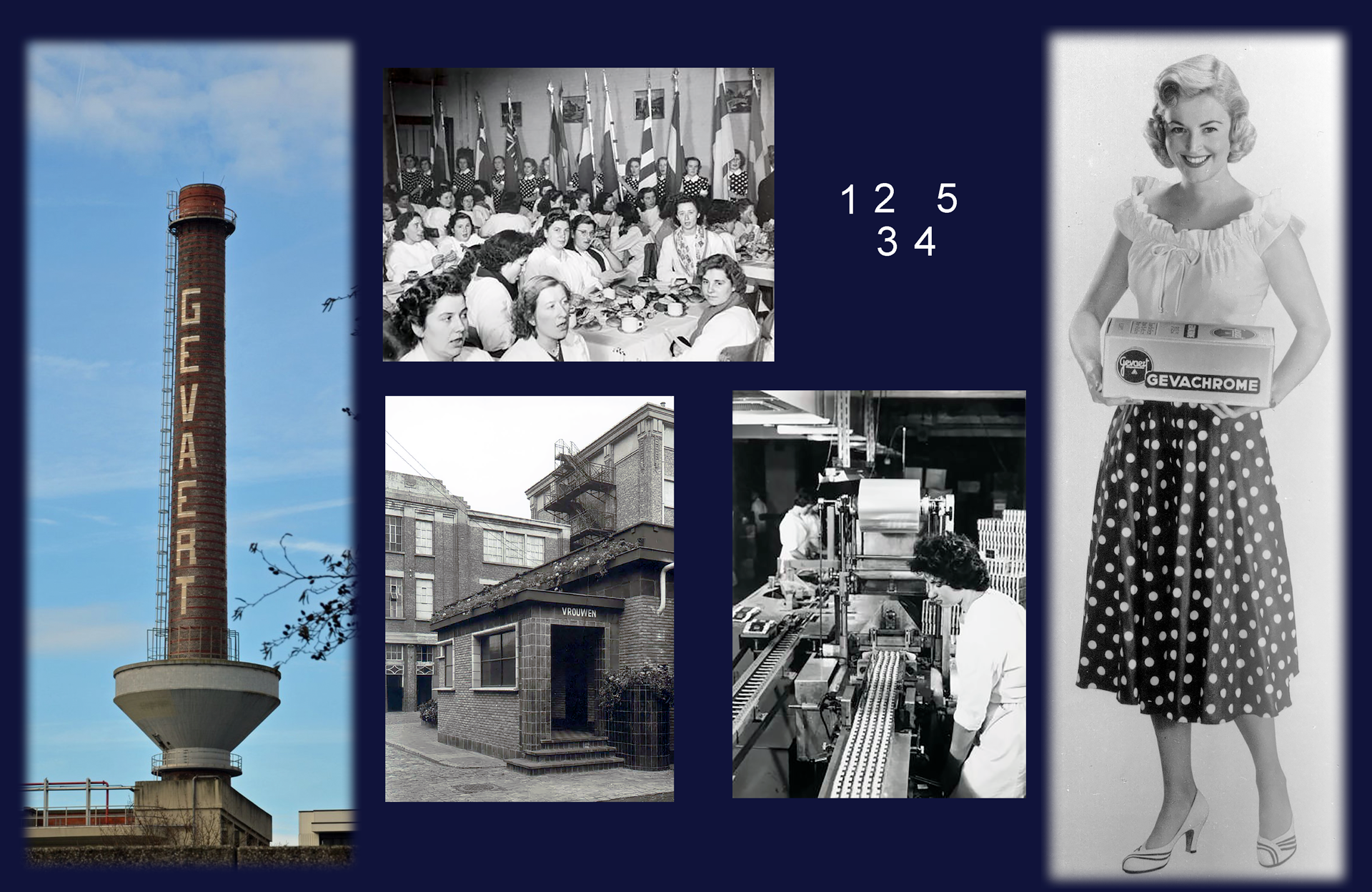
1) View of the ‘Grote Schouw’, the landmark of Gevaert on the site in Mortsel, 1928; 2) The female staff celebrated Christmas every year. In the background, girls wear characteristic Gevaert dresses with polka dots, 1950; 3) The toilet visits were also rigorous in the early 1960s – sharp at twenty to ten in the morning and at twenty to four in the afternoon. The girls set off in rows of four, escorted by a chaperone. It was a bit of a walk, because the girls did not have a toilet in their own department.; 4) Roll film and small format films are packed on the assembly line, ca. 1960; 5) Advertisement for Gevachrome film. Here too the “polka dot” cannot be absent.
- Geva 66
- Gevabox
- Gevalux 144
- Gevaphot
- Rex Junior
- Rower
- Aviphot Pan Topographic Base Safety Film (80mm)
- Gevaert Gevabrom
- Gevaert Gevapan
- Gevaert Gevacolor (negative and reversal)
- Gevaert Orthobrom
- Gevaert Panchromosa
- Gevaert Panchromosa Micrograin
- Gevaert Superchrom
- Gevaert Express Superchrom
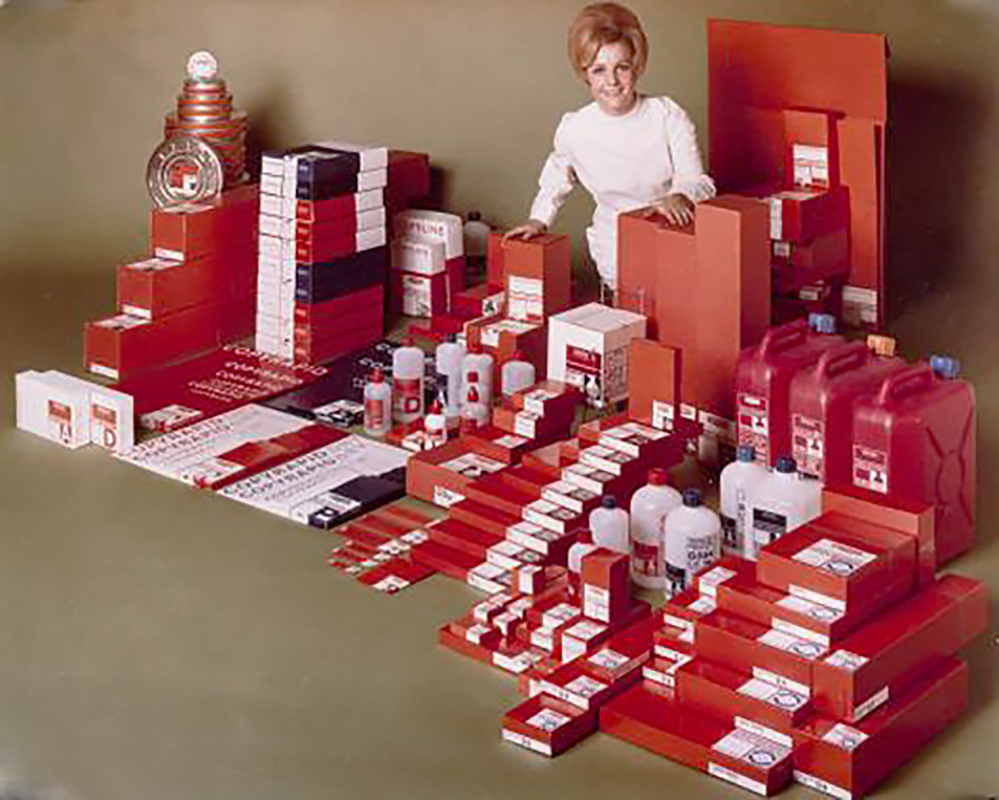
Overview of the Gevaert range, shortly after the merger in 1964, 1965-1966

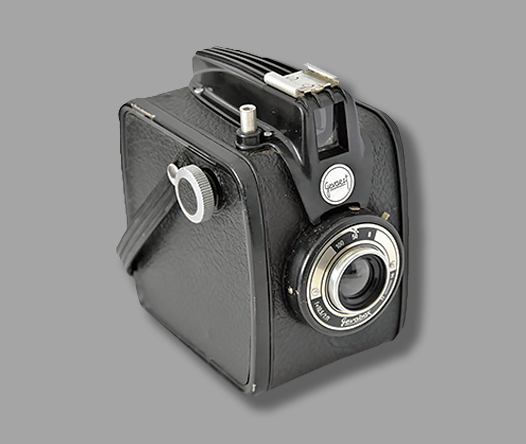
Gevabox was made in West Germany in 1955-1959. Reportedly camera was manufactured by Bilora not Gevaert, but it was sold under its brand. The camera takes 6×9 exposures on 120 roll-film. It’s fully made out of heavy metal alloy, except large plastic viewfinder. It has an accessory shoe, most likely for the flash lamp, which can synch with the socket on the lens. The lens is a fixed focus 105mm f/11. There are two aperture stops: f/11, f/16 & three speeds: 1/100, 1/50, B (Bulb). For the box cameras manufactured at that time this is uncommon to have that many options.
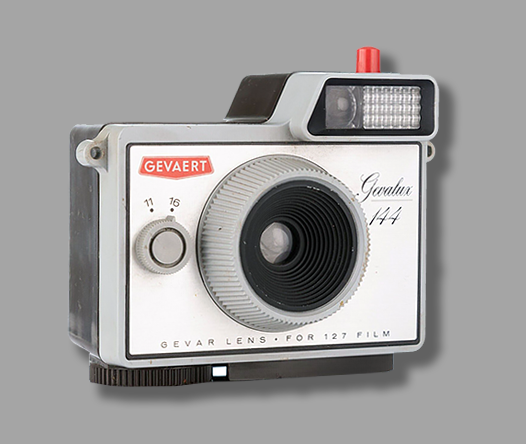
The Gevalux 144 was introduced in 1965 and made for Gevaert by Ansco in Binghamton, New York, USA. The Gevalux 144 was produced for the European market. The same camera was also produced by Ansco for the American market during the same period under the name Ansco Cadet II. The Gevalux 144 is made of plastic and has an aluminum front plate. On the front of the camera is a dial to select the aperture (f/11 or f/16). Under the camera is a large rotary knob to advance the film. The detachable flash works on 2 AA batteries. The Gevalux takes 12 photos of 4 x 4 cm format on 127 film.
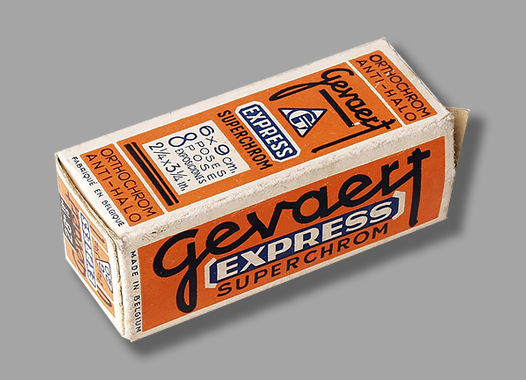
Gevaert Express Superchrom film.
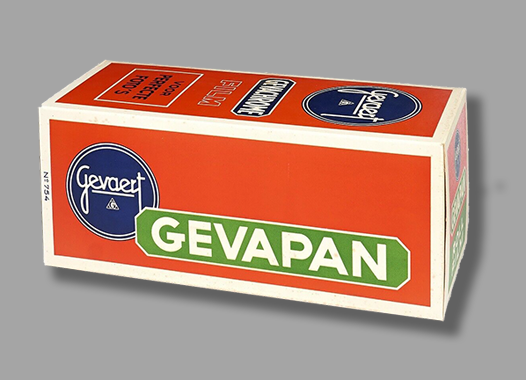
Gevapan Gevachrome film.
 On the internet I found a very interesting Dutch PDF file about the history of (Agfa)Gevaert. It highlights the history of the company from the perspective of (former) employees.
On the internet I found a very interesting Dutch PDF file about the history of (Agfa)Gevaert. It highlights the history of the company from the perspective of (former) employees.
The title I work(ed) at Gevaert is a nod to the booklet that new employees received when they started working there, and in which the history and working methods were explained in detail.
Gevaert proved that it wanted to invest in its employees. That it worked is evident from the interviews with ex-employees and/or family members, who suggest an enormous bond with the company. ‘De Gevaert’ was not your work, it was your (social) life. During and after working hours.
Click here or on the illustration for the PDF.
COMPANY NAMES:
1885: E. Girard et A. Boitte; 1899: J. Girard et Cie; 1909: Girard et Boitte.
COMPANY ADDRESSES:
1885: no 42 Rue de L’Echiquier in Paris.
E. Girard et A. Boitte was founded in 1885 as a bookstore. In 1899 the company was dissolved in favor of the new limited partnership J. Girard et Cie.
J.Girard et Cie was a company which was also located at no 42 Rue de L’Echiquier in Paris, close to the Gare du Nord. They did most of its business via mail order. So it makes sense that a lot of advertisements for the Girard cameras are often found in the newspapers and magazines dated around 1900. Somewhat the Sears-Roebuck of France did in the late 19th, early 20th century.
Remember at the time the main transport was horse or train, so mobility was not like we are used to today. Thus for all the people, who lived far away from the main cities, at this time, probably the bulk of the population, mail order houses was a very popular alternative for shopping. The articles could be selected at home from the catalogue and delivered by post with payment by instalments.
Girard et Cie began as a company supplying lamps, books, cameras, and art-works. In 1899 they added phonographs, initially selling the Pathé Gauloise in a custom Cabinet, manufactured by Pathé. Later, J. Girard et Cie sold a series of phonographs, special designed by Pathé and only obtainable by the own mail order.
The J. Girard & Cie. produced only a few high quality cameras for the amateur market. They marketed years after years different cameras bearing the same name. This is true with the name “Le Reve” (The dream) but this is also true with the name “Le Radieux” (The Radiant).
This Radieux used the so-called “VIDIL” film, allowing framing and focusing on portions of tracing paper, sandwiched between the sensitive film surfaces, themselves protected from light by a protective paper.
The Radieux offers different shutter speed. The fastest one being 1/60 sec. The settings, diaphragm, shutter speed, and focusing are actuated by means of curious fined knob fitted with needle/scale systems. The lens is protected by a flap while not in use.
On May 1, 1909 J. Girard et Cie was dissolved in favor of the new general partnership Girard et Boitte (phonographs, cameras, weapons, etc.).
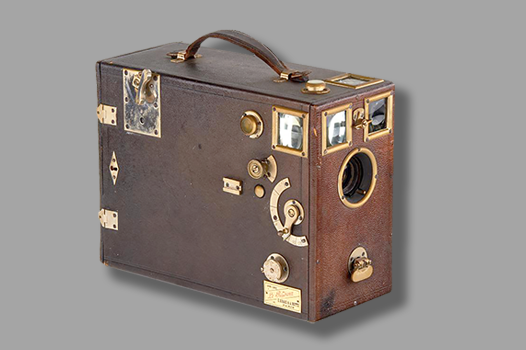
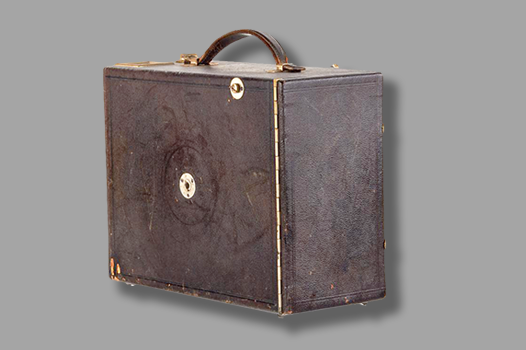
This Radieux may be loaded with 12 glass plates or 24 film plates. Offering two spirit levels, it was a top class detective camera. The total price of the camera, bought on credit was 135 francs.
FOUNDER: Heinrich Loebstein
COMPANY NAME:
Gnome Photographic Products P.L.C.; The company closed in 1994.
COMPANY ADDRESSES:
1938: Treforest Industrial Estate Pontypridd, Wales; 1945: Caerphilly Road, Cardiff, Wales; 19??: 21a Working Street, Cardiff, Glamorgan, Wales.
Gnome were a company based in Cardiff, Wales, making darkroom equipment and projectors – and a few cameras. They also seem to have sold a few rebadged cameras from other manufacturers such as the Adox Polo series. Gnome also imported film from Germany, made by Adox.
Gnome Photographic Products actually had its roots in pre-war Stuttgart. It was there that Heinrich Loebstein set up a small factory that produced photographic equipment. His fine quality enlargers, viewers and projectors were exported to various parts of the world, including Cardiff.
Loebstein, being Jewish, found himself under the threat of being placed in a concentration camp by the Nazis, so in 1938 he fled with his family to the UK, where he had previously established strong business contacts. He settled in the Welsh town of Pontypridd where he re-set up his company in Britain’s first industrial estate at Treforest. The Treforest complex was meant to encourage new types of industries to south Wales which was still suffering the harsh economic blight of Depression. Gnome was one of the very first companies to establish itself there.
Eighteen months after the outbreak of WW2 the Ministry of Aircraft Production took over his new factory at Treforest and Gnome relocated to Cardiff. There they produced enlargers for the Admiralty for use in aerial reconnaissance. It must have been satisfying for Loebstein to contribute to the fight against fascism in such a positive way, using technology he had begun to develop in Germany.
After the war Gnome moved into new premises on Caerphilly Road, Cardiff, which became their home for many years to come. They continued to manufacture enlargers and projectors, taking out various patents along the way. In fact, Loebstein helped to popularise photography in the UK.
We find Gnome as a participant in the British Industries Fair of 1947. There, on the ground floor of the Olympia Hall, they exhibited in stand no. A 1016 Photographic Equipment including 17.8 cm by 12.7 cm Industrial Enlargers, 5.7 cm square and 35mm Portable Enlargers, Lighting Outfits, Developing Tanks, Printing Boxes, Masking Frames, in fact all equipment for the Amateur or Professional Photographer.
The Gnome Pixie was made in 1949. Gnome only made a few cameras, with the Gnome Pixie being one of the first ones they made. There was also a couple of variations on the Pixie, a leatherette covering was added to one, and a more ‘luxurious’ Model II was also produced, featuring chrome edges around the front.
Another variation was the Gnome Baby Pixie, a smaller version of the Pixie which produced 4.5 x 6 cm negatives, and a final version made in 1951, the Gnome Pixie Flex, which saw the introduction of a reflex viewfinder and the repositioning of the shutter to the top of the camera. Gnome later released/re-badged Adox Polo cameras.
Hitherto enlargers had been expensive but in 1948 he revolutionised the industry by introducing large batch production. This brought the unit price down from an average of £40 to £11 – well within the financial grasp of the amateur. By 1960 80% of enlargers sold in the UK were produced by Gnome.
Gnome exported their goods to 72 different countries. Also in 1960 they became a public company issuing 400,000 shares. By this time Loebstein had repossessed his old factory in Stuttgart but nothing was produced there – it was used instead as warehouse for Gnome’s exports to Germany. The company closed in 1994.
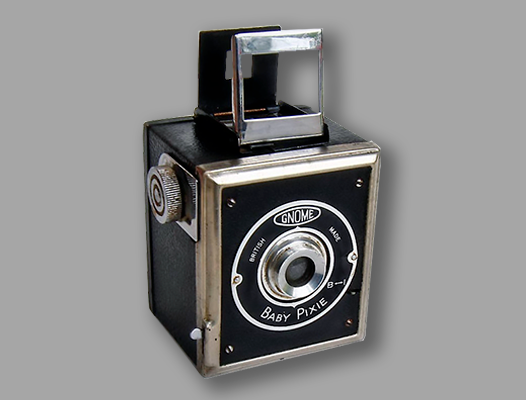
Gnome: Baby Pixie c1950-1952. 620 film, 4.5x6cm exposures, box-type camera. Metal body. Black or chrome edges, black crackle-finish or leatherette covering.
ENLARGER AND Camera ListinG & PATENTS
Gnome Alpha Deluxe
Gnome Rangefinder Alpha II
Gnome Rangefinder Sixty-Six II
Gnome Universal Alpha
Gnome Universal Alpha II
1954 Patent – Improvements in or relating to optical projection apparatus, particularly photographic enlarging apparatus.
1971 Patent – Photographic Slide Projectors.
Gnome had little expertise in camera design, but made a few very basic models from 1949. In later years they sold a Gnome rebadged Adox Polo.
Gnome Baby Pixie
Gnome Pixie
Gnome Pixie Flex
Gnome Pre-view

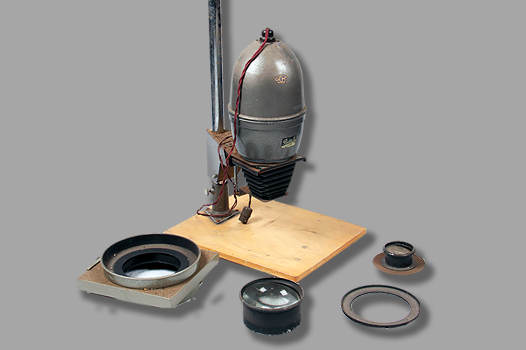
Gnome Beta II Photographic Darkroom Enlarger
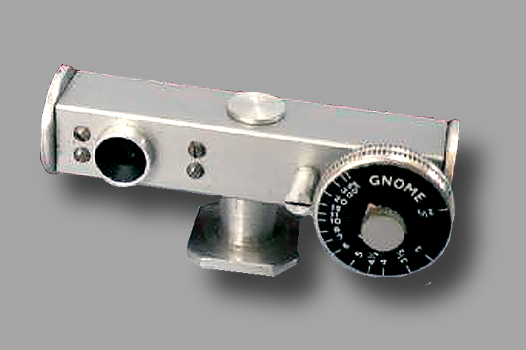
Auxiliary film camera rangefinder, made in Cardiff.
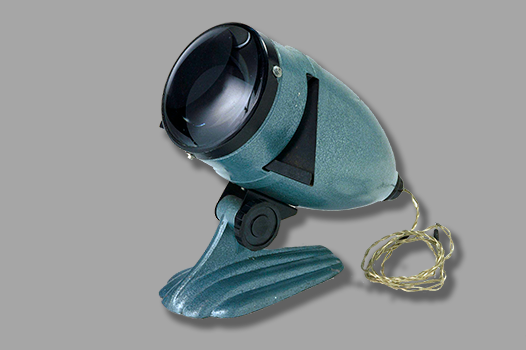
Projector painted in blue metallic paint. Gnome manufacturers label on top
COMPANY NAMES:
1886: C.P. Goerz Company; 1890: Optische Anstalt C. P. Goerz; 1903: Optische Anstalt C. P. Goerz AG; 1908: Goerz Photochemisches Werk GmbH; 1926: Goerz merged with ICA, Contessa-Nettel and Ernemann to form Zeiss Ikon; the German Branch of the Goerz was no longer marketed.
– – – – –
1905: American Branch C. P. Goerz American Optical Co; 1926: the American branch continued; 1975: the American branch closed operations.
1886: Berlin-Friedenau, Rheinstrasse 44-46; 1890: Hauptstrasse 7a, Schöneberg (as from 1920: Berlin-Schöneberg); 1903: Rheinstrasse 45/46, Berlin-Friedenau (Rural community of Friedenau, from 1920: district of Schöneberg); 1908: Goerzallee 299, Berlin-Zehlendorf; 1916: Goerzallee 271, Berlin-Zehlendorf
– – – – –
1905: C. P. Goerz American Optical Co. located at 317 East 34th street New York.
The Optical Institute C.P. Goerz was a Berlin-based company specializing in the manufacture of optical lenses and cameras.
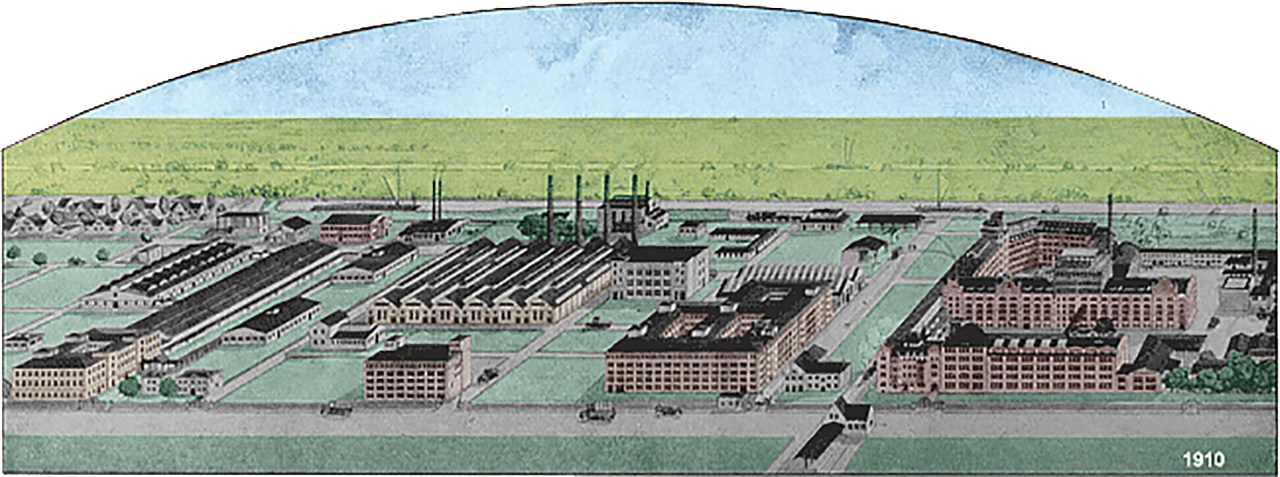
From 1898 Goerz had his own design office for the mechanical parts of the instruments. In 1909 a department for meteorological and aeronautical equipment was set up, whose scientific management was taken over in 1910 by the meteorologist and balloonist Arthur Berson. In 1911, a reflecting telescope for the Technical University of Charlottenburg was the first astronomical instrument to be manufactured. Another reflecting telescope is now in the observatory of the German Museum in Munich. In 1911 the number of employees had grown to 2,500. The company included not only the optical and mechanical workshops, but also a tool shop, a forge, an engraving shop, a saddlery, a paint shop and several workshops for producing camera bodies.

The Goerz factory in Berlin-Zehlendorf (das Goerzwerk). Up to 12,000 employees worked in the new plants. Goerz, who had already introduced the eight-hour day and paid holidays in Friedenau, looked very well after his employees. He bought the shares of the existing industrial railway so that his employees could easily reach the factory with the so-called Goerzbahn.
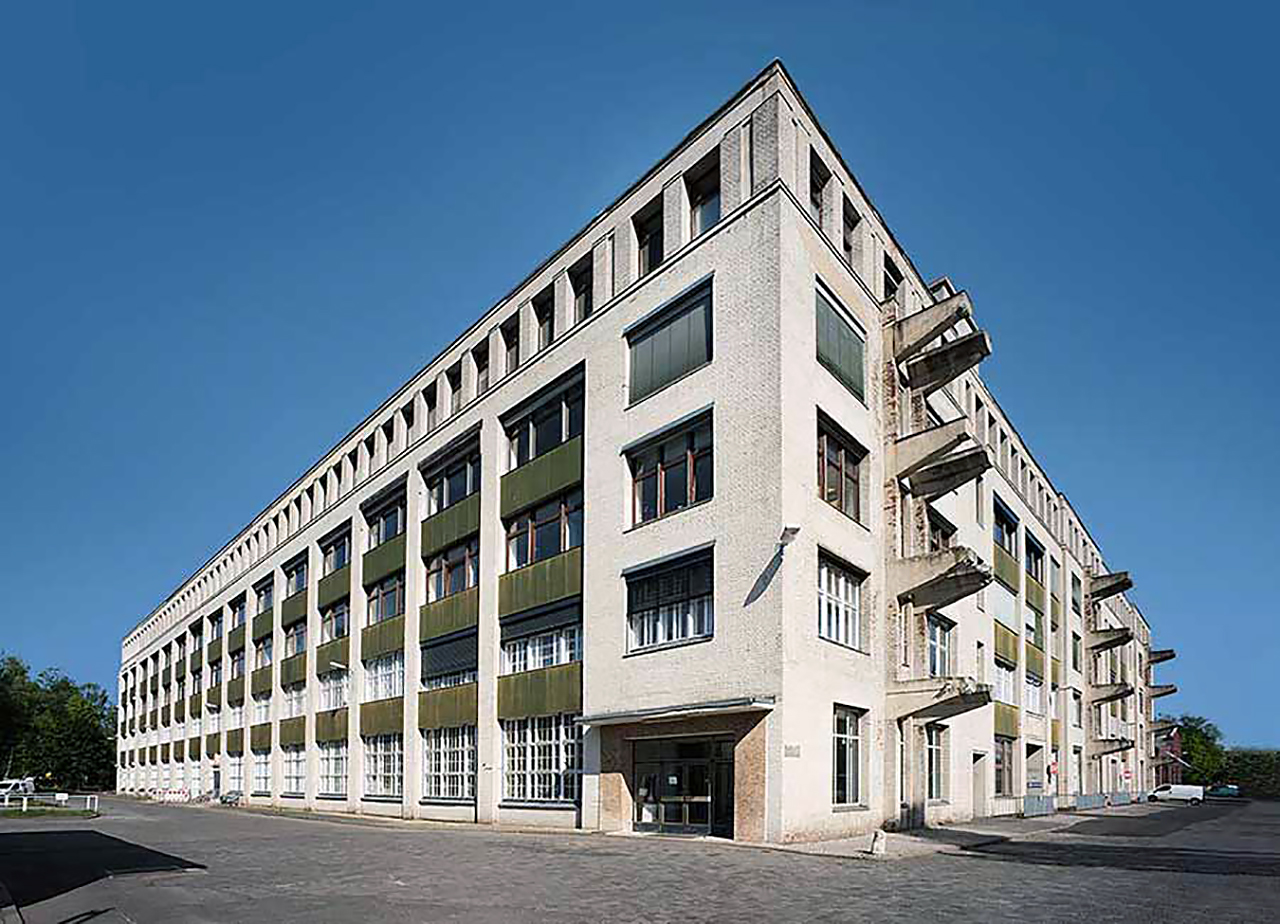
After fire damage in the Second World War and renovations in the 1960s, the appearance of the building changed radically. The formerly red clinker brick facades have disappeared under a layer of white paint, the elegant tiled concrete parapets are hidden behind metal cladding. New coarse-pitched windows have replaced much of the original mullioned windows.
 Carl Paul Goerz was born in Brandenburg, Germany in 1854. Little is known about his family or his early childhood. After completion of middle school, he apprenticed with lens maker Emil Busch’s company in Rathenow. Within this four-year period, he acquired the necessary knowledge and resources to work independently.
Carl Paul Goerz was born in Brandenburg, Germany in 1854. Little is known about his family or his early childhood. After completion of middle school, he apprenticed with lens maker Emil Busch’s company in Rathenow. Within this four-year period, he acquired the necessary knowledge and resources to work independently.
During the next decade, Herr Goerz honed his skills throughout Europe, serving primarily as a sales agent representing several German companies. He also became a shareholder of in Eugen Kraus’ optical distribution office in Paris.
Returning to Berlin in 1886, Herr Goerz and one assistant opened a mail order business for mathematical instruments for schools and small optical instruments. However, upon the death of his mentor Emil Busch in 1888, he recognized the potential market for the assembly and manufacturing of his own line of products.
Along with his friend and business partner, photographer and part-time inventor Ottomar Anschuetz, Herr Goerz began producing his own line of easy-to-use cameras perfect for the amateur or recreational photographer. By taking over F. A. Hintze’s workshop in 1888, his company became a camera maker itself, named Optische Anstalt C. P. Goerz since 1890. It was based in Berlin-Friedenau.
In 1888 Goerz employed the Swiss optical engineer Carl Moser and the optician Karl Hertel to start the development of lenses. Carl Moser developed the Lynkeioskop, pre-anastigmat or rectilinear lens for the fledgling company.
In 1889, Goerz heard about the invention of the focal plane shutter, known at the time as the instantaneous shutter, from the photographer Ottomar Anschütz. With this invention, exposure times of 1⁄1000 seconds were achieved, making it possible to photograph moving objects for the first time. Goerz acquired the right to sole production and, with the Goerz-Anschütz-Moment-Camera, offered the world’s first focal plane shutter camera. The company quickly became well known.
By the last decade of the nineteenth century, Goerz’s factory was manufacturing cameras, lenses, focal-plane shutters, prism telescopes, ‘Trieder’ binoculars, reflectors, and projection equipment. A specialty of Goerz were the cameras with “rouleau-shutter” since the company had the exclusive right to produce the fast focal plane shutter (1/1000sec.) that Ottomar Anschütz (1846-1907) had invented in 1883.
These were mainly, but not exclusively, strut folding cameras, known as Ottomar Anschütz or Goerz Anschütz cameras, and many branded Ango as word derivation for Anschütz and Goerz. The first one was the Goerz-Anschütz Moment-Apparat of 1890, a box camera for 9x12cm plates with a good lens mounted on the front plate.
Optical successes
After Herr Moser’s death in 1891, the optician Emil von Högh was hired, and lens construction at Goerz took off enormously. Von Högh invented the Dagor lens, which has the distinction of being the first symmetrical lens that fully corrected for the ongoing problem of astigmatism. This double anastigmat lens became an enormous success, with annual sales steadily growing to a corporate high of 200,000 in 1908.
The license for Great Britain was awarded to the company Ross & Co. in London in 1893, and that for Austria-Hungary to Karl Fritsch in Vienna. The Goerz-Hypergon followed in 1900, an anastigmatic wide-angle lens with a field of view of 135°.
The reputation of the company also increased through custom-made products, for example for the animal photographer Carl Georg Schillings. A 3-color-projector and a Reflector telescope was made for the famous Dr. Adolf Miethe. The telescope was specially built for the expedition to Sandnessjøen in Norway led by Adolf Miethe to observe the solar eclipse of August 21, 1914. Other products of Goerz were meteorological and aeronautical instruments, binoculars and Alethar repro lenses and another camera shutter, the Sector shutter.
As early as 1891, Goerz received the first orders for the manufacture of military optics. The company became a supplier for the Imperial Army and Navy Office as well as for many foreign military administrations. From 1897 lens telescopes were manufactured in large numbers.
In 1899 Goerz took over the representation of the company Barr and Stroud in the German Reich for the distribution of optical range finders. In 1903 a special military division was established and subsequently produced rangefinders, submarine periscopes, binoculars and gun sights. The Optical Institute C.P. Goerz became the world’s largest manufacturer of military optics.
Goerz in the early 20th century
C.P. Goerz products made their American debut at the 1893 World’s Fair in Chicago. It would establish its first permanent residence in the United States as the C. P. Goerz Optical Company, located at 317 East 34th Street in New York City in 1905. This company continued to operate independently in the US until 1972.
Shortly after 1905, the international manufacturer’s first color slide projectors and yellow glass plate filters for landscape photography were rolling off assembly lines. In 1908, an alliance with the Balloonist Joseph Arthur Berson resulted in the production of balloon and air survey cameras. Photojournalists would soon have a new tool at their disposal in the form of a ‘night camera’ with customized lenses and shutters.
Until WWI many great companies cooperated with Goerz. Rochester Optical Co. used Goerz lenses for its Snappa Camera in 1902, Kodak for its No. 3 Folding Pocket Kodak in 1901, and Ross in London got a license to make Dagor double anastigmat lenses already in 1893.
In 1903 Goerz became a stock market company with a share capital of 3.5 million marks. In 1908, Goerz Photochemisches Werk GmbH was founded in Berlin-Zehlendorf. This company produced roll film and film for the movie industry. In 1910, an interest group was formed with the joint-stock company Hahn for optics and mechanics, Ihringshausen/Cassel, in which the optical institute C.P. Goerz held the leadership.
Sales branches abroad had already been opened in the 1890s, for example in Paris in 1893, in New York in 1895 and in London in 1899. As already mentioned, in 1902 the first branch was established in New York. It was followed by branches in Saint Petersburg (1905) and in Pressburg (1908). At that time the company had further factories in Berlin-Friedenau, Vienna, Pressburg (=Bratislava), New York and Winterstein.
During WorldWar I
The plant in Munich-Sendling was extensively modernized, but then moved to Schönow (Zehlendorf) during the First World War, where production was set up at Goerzallee 271 next to the new “Goerzwerk”. Headlight production was taken over by the Körting & Mathiesen company in Leipzig-Leutzsch while the war was still going on. Here mainly arc lamps with Fresnel lenses were built for lighthouses.
During the First World War, Goerz’s main production was making panoramic telescopes, often used as periscopes in submarines for the German and Austrian military, but started also making electrical search lights. By war’s end, Goerz had global factories and distribution offices throughout Europe and the United States and more than 12,000 employees.
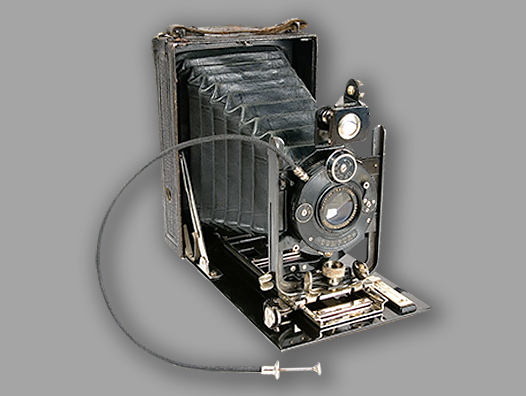
The Goerz Taro-Tenax is a series of folding bed plate medium format to large format film camera, manufactured by Optische Anstalt C.P. Goerz AG. Friedenau, Berlin, Germany and produced between c1912-1926. It has a leather covered aluminium body with a brilliant frame finder centered over the lens. Many variations were made over the production period, similar to the Taro-Tenax but cheaper.
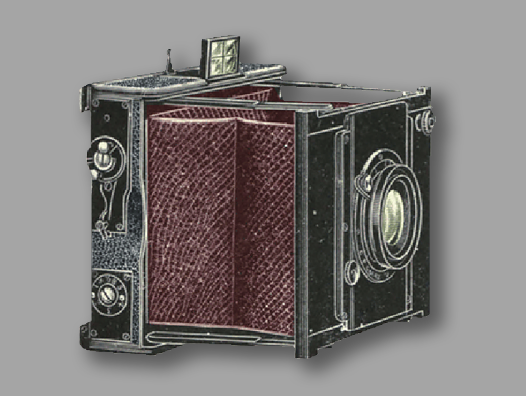
The Goerz Anshutz Tropical Camera was manufactured from ca. 1896 to 1922. This camera was constucted of hardened and impregnated wood suitable for use in the tropics. Constructed to resist bending and warping, with a black finish. The bellows were made from Russian leather and the camera body was covered in Russian leather to resist the attacks of insects. The metal parts are nickelled brass.
- Flach-Camera or Autofoc-Tenax
- Vest Pocket Tenax or Plate Tenax
- Coat Pocket Tenax
- Pocket Tenax
- Rollfilm Tenax or Roll-Tenax
- Taro Tenax
- Manufoc-Tenax
- Stereo-Pocket-Tenax or Stereotenax
- Roll-Tengor
- Box Tengor
- Piccolissima
- Universal-Reise-Camera Insuperabilis
- Spezial-Ballon-Camera
- Goerz Folding Reflex Camera
- Ango Jagd-Reflex
- Anschütz Ango
- Ango High-Speed
- Ango Luxus
- Ango Stereo
- Ango Stereo-Luxus
- Anschütz Box (Moment-Apparat
- Anschütz Klappkamera
- Goerz-Anschütz Stereo-Klapp-Camera
- Goerz-Anschütz rouleau shutter
- Goerz Sektoren-Verschluss
Timeline of the Goerz company
- 1886 – The C.P. Goerz Company was founded as a mail order company by Carl Paul Goerz (1854 -1923) producing mathematical and drawing tools for schools, with only one assistant. It was located in Berlin-Friedenau, Rheinstrasse 44-46.
- 1887 – Carl Moser an employee of the company started the photo supply business in the company.
- 1888 – Goerz acquired the F. A. Hintze’s mechanical workshop and began producing cameras.
- ±1889 – Goerz began making optical lens with the trade name of Lynkeioskop C/2. Lens making became the primary business. A larger factory was established at Schoneberg.
- 1890 – The company name was changed to Optische Anstalt C. P. Goerz and the company continued to expand operations in Berlin.
- Goerz products were first introduced to the American public during the World’s Fair at Chicago and they subsequently opened a company office in New York. This branch would begin producing cameras in 1902.
- 1892 and 1893 – The double anastigmat type of lens were introduced with Goerz taking the lead. Goerz has the credit of having introduced the first symmetrical lens fully corrected for astigmatism.
E. Von Hoegh invented the Dagors and other lenses for Goerz that became known for their high quality. - 1894 – It was recorded that 20,000 lenses have been sold.
- ±1896 – Goerz obtained rights to produce the Ottomar Anschutz focal plane shutter with speeds up to 1/1000 of a second. Cameras were produced with Goerz-Anschutz name and in approximately 1905 shorted to Ango derived from the first two letters of the two names ANschultz and GOerz.
Ottomar Anschutz (1846-1907) had invented the shutter in 1883. Additional in this year, the company began the manufacture of other non-photographic optical goods, such as the well known Trieder binoculars, the Prism telescope, the panoramic telescope for military use. - 1898 – The optical manufacturing was transferred to a specially built factory in Friedenau due to expansion, which this part of the business now employed 1900 workpeople.
- 1900 – It was reported that 60,000 lenses have been sold.
- 1903 – It was reported that 100,000 lenses have been sold.
- 1905 – The American branch adopted the name C. P. Goerz American Optical Co located at 317 East 34th street New York which contained full manufacturing capabilities.
- 1908 – It was reported that 200,000 lenses have been sold. Goerz Photochemisches Werk GmbH was founded in Berlin-Zehlendorf. This company produced roll film and film for the movie industry.
- 1910 – Goerz became owner of the Sendlinger Optische Glaswerke, an optical glass maker near Munich
- 1923 – Carl Paul Goerz died.
- 1926 – The German branch of Goerz merged with ICA, Contessa-Nettel and Ernemann to form Zeiss Ikon. As a result of the merger, only the Zeiss company continued to produce lenses.
The German Branch of the Goerz was no longer marketed. However the American branch continued. - 1927 – The Burke & James company, led by George Drucker, bought the German Goerz optical company holdings, complete with all existing lenses, tooling, and rights to the name and formula.
- 1975 – The American branch closed operations.
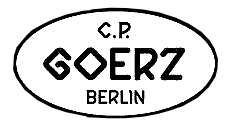
after WorldWar I
After the war further making of military equipment was forbidden by the Peace Treaty of Versailles. The company tried to make mechanical calculators and other scientific instruments instead but failed to regain former success.
In the mid-1920s, Hahn developed the profile cylinder, which later became one of the main sales drivers for Zeiss Ikon AG. Goerz made itself independent of suppliers from the glass industry by purchasing the Sendlinger Optical Glass Works, founded by Joseph von Fraunhofer and Carl August von Steinheil.
Merger
Herr Goerz was an early advocate for socio-economic equality, and ensured that his employees worked no more than 48 hours per week and received generous paid vacation and holiday packages. Carl Paul Goerz died in Berlin on January 14, 1923.
Three years later, in 1926, the German branch of Goerz was saved from bankruptcy by being merged with ICA, Contessa-Nettel and Ernemann to form the Zeiss-Ikon Company. This had major consequences for the company; the Carl Zeiss company held a majority stake in the new company and demanded that the other firms end their lens production. This was the end of the famed Dagor lenses, at least in Europe.
During World War II, the company ran its own forced labor camp at Goerzallee 271. With the formation of Zeiss Ikon AG, the production profile of Goerz was greatly changed and the manufacture of optical items was almost completely abandoned in favor of the 53% majority holding of Zeiss-Werke in Jena. Cameras and lighting equipment for cinema projectors and profile cylinders were now being produced in Berlin.
An Austrian branch of C. P. Goerz was still active in the 1950s, introducing an astonishing little subminiature reflex camera with 6 element Helgor lens, the Minicord.
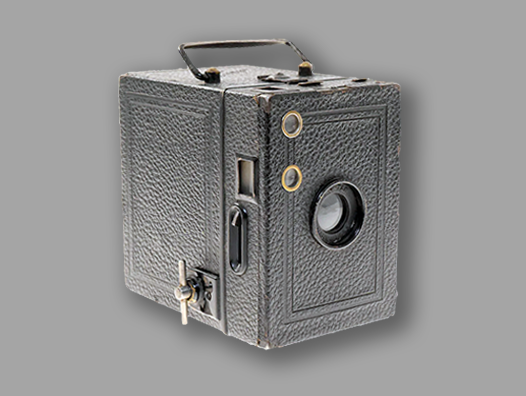
Box Tengor is a series of medium format film box cameras made by Zeiss Ikon and produced between 1926-1956. It is a continuation model of Goerz Box Tengor. There are many types of the camera during its long production period for 127VP, 120, 116/616, and 129 film sizes. This is the Type 54/2 early version, the first of the series, made between 1926-28.
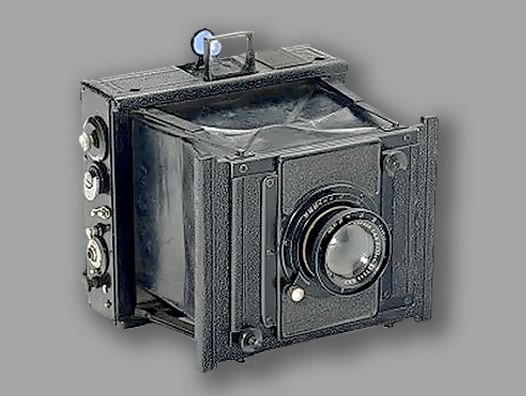
A late model Goerz-Anschütz Ango; a series of strut folding plate film medium format to large format camera manufactured by Goerz, and produced between c.1896-1922. At early times, Goerz’s specialty were cameras with the fast rouleau shutter that the company had licensed exclusively from its inventor Ottomar Anschütz. A long running series of such cameras was named after 1905 as Ango, a word derivation for Anschütz and Goerz.
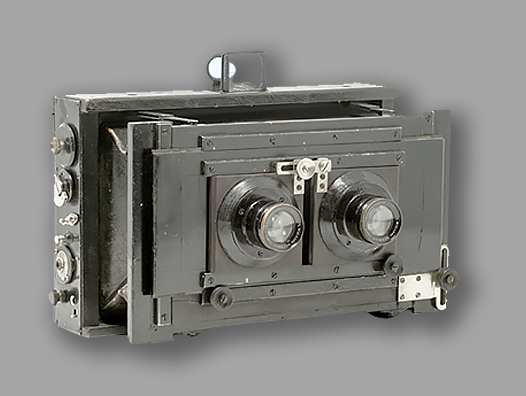
Leather covered wood body, Anschütz Stereo-Ango camera. 6×13, 8×17, 9×14, 9x18cm plates. The Goerz Stereo Ango was introduced in 1905 as an improvement of the Goerz Stereo Anschütz Model I. It has the self-capped shutter. The viewfinder is optical with a blue back lens, and the front standard is finished in polished wood. The format of this particular variant is 9 x 18 cm. Overall it is a low cost set up.
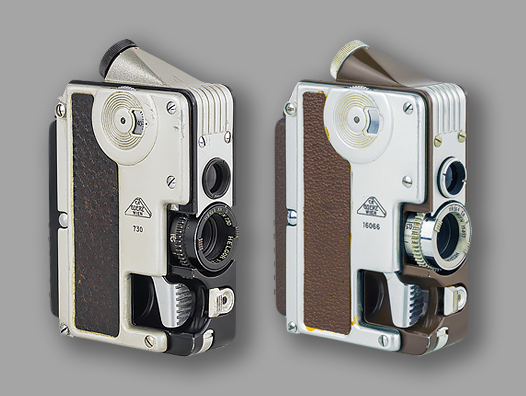
Goerz introduced the Minicord around 1951 (left in the photo). It is one of the highest quality subminiatures ever built. It is about the size of a pack of cigarettes, and is a twin lens reflex. The viewing screen is a bit larger than the 10x10mm image size. It accepts regular 16mm film loaded into special cassettes. Around 1958 the Minicord was replaced by the Minicord III (right in the photo).
FOUNDER: UNKNOWN
COMPANY NAMES:
1914: Gosudarstvennyi Optiko-Mekhanicheskii Zavod; 1921: State Optical Plant (GOZ); 1930: Gosudarstvennyi Optiko-Mekhanicheskii Zavod (State Optical and Mechanical Plant) (GOMZ); 1962: Leningrad Optical and Mechanical Association of Enterprises (LOOMP); 1965: Leningradskoye Optiko-Mechanicheshkoye Obyedinenie (Leningrad Optical and Mechanical Association) (LOMO)
COMPANY ADDRESS:
1914: the outskirts of Saint Petersburg-Leningrad;
Nowadays, the company is still operating and seems to have left all camera production behind, and is focusing on scientific and industrial grade optics.
GOMZ was one of the Soviet Union’s oldest optical factories. It is famous for early models of the Lubitel TLR and Smena cameras as well as designing what some believe is the very first 35mm SLR ever: the Sport.
 In 1914, the company was originally established during the Franco-Russian Alliance as a joint French and Russian photographic factory, a plant for the production of optical and mechanical devices. It was opened on the outskirts of the newly renamed city of Petrograd (both formerly and currently known as Saint Petersburg).
In 1914, the company was originally established during the Franco-Russian Alliance as a joint French and Russian photographic factory, a plant for the production of optical and mechanical devices. It was opened on the outskirts of the newly renamed city of Petrograd (both formerly and currently known as Saint Petersburg).
When World War I erupted, production switched from cameras and lenses to military optics such as instruments for checking the sighting lines of guns, sights, stereo tubes and periscopes for artillery.
After the Great War ended, the company was nationalized and underwent a series of reorganizations. In 1921, this plant was renamed the State Optical Plant (GOZ). After that, the plant was renamed and reorganized several times, until in 1930 the company was renamed the State Optical and Mechanical Plant (GOMZ).
GOMZ continued to manufacture consumer cameras over the next thirty years or so, including the original Lubitel TLR, Lubitel 2, and several models of the popular Smena series of 35mm viewfinder cameras, as well as designing what some believe is the very first 35mm SLR ever: the Sport.
Sport is a SLR camera, designed for 35 mm film. It is considered one of the world’s first small-format cameras of this type. An experimental batch of Sport cameras was released in 1934. Serial production was launched at the GOMZ plant in Leningrad and lasted from 1937 to 1941. Over the entire production period, about 19000 copies of the Sport camera were released. Other cameras of GOMZ that must be mentioned are Fotocor, Tourist and Reporter.
The Smena series was made in the city of Leningrad, Russia in the GOMZ factory. GOMZ transitioned to optical production in 1930 as one of the first Soviet factories to produce cameras and lenses. One of it’s first products was the folding Fotokor-1, which was an inexpensive copy of a German 9×12 folding camera, but in the years that would come, GOMZ would produce a dizzying array of models. Most GOMZ cameras were of the inexpensive variety which allowed them great success at introducing photography to the masses in the Soviet Union.
In 1939, GOMZ would release a camera with an all Bakelite body and a front “scissors” folding design called the Smena (Смена) which strongly resembled the Kodak Bantam.
Designed by Ilya Grigoryevich Shapiro who was responsible for several other cameras including the later GOMZ Leningrad, the original Smena (which loosely translates to ‘change’ or ‘shift’) featured several improvements over the Bantam including a more versatile shutter, a focusing lens element, and a different viewfinder. Despite being a novel little camera, the original Smena was not in production long, likely due to Russia’s involvement in the war.
 The GOMZ factory’s location in Leningrad spared it from destruction during the war, so once it had ended, GOMZ was one of the first Soviet factories to resume producing cameras and optical products.
The GOMZ factory’s location in Leningrad spared it from destruction during the war, so once it had ended, GOMZ was one of the first Soviet factories to resume producing cameras and optical products.
For a moment we go to Leningrad in the year 1945. The Soviet Union had just triumphed in the Great Patriotic War and was licking its wounds. Rebuilding and revitalisation was nowhere more necessary than in Leningrad after 900 days of hardship under German siege.
To kick-start the rebuild, the Soviet Union dismantled various German optical factories and shipped them eastward. One of the factories to receive German tooling and expertise was GOMZ, which consequently reappeared in 1946 with their first new camera: the Komsomolets.
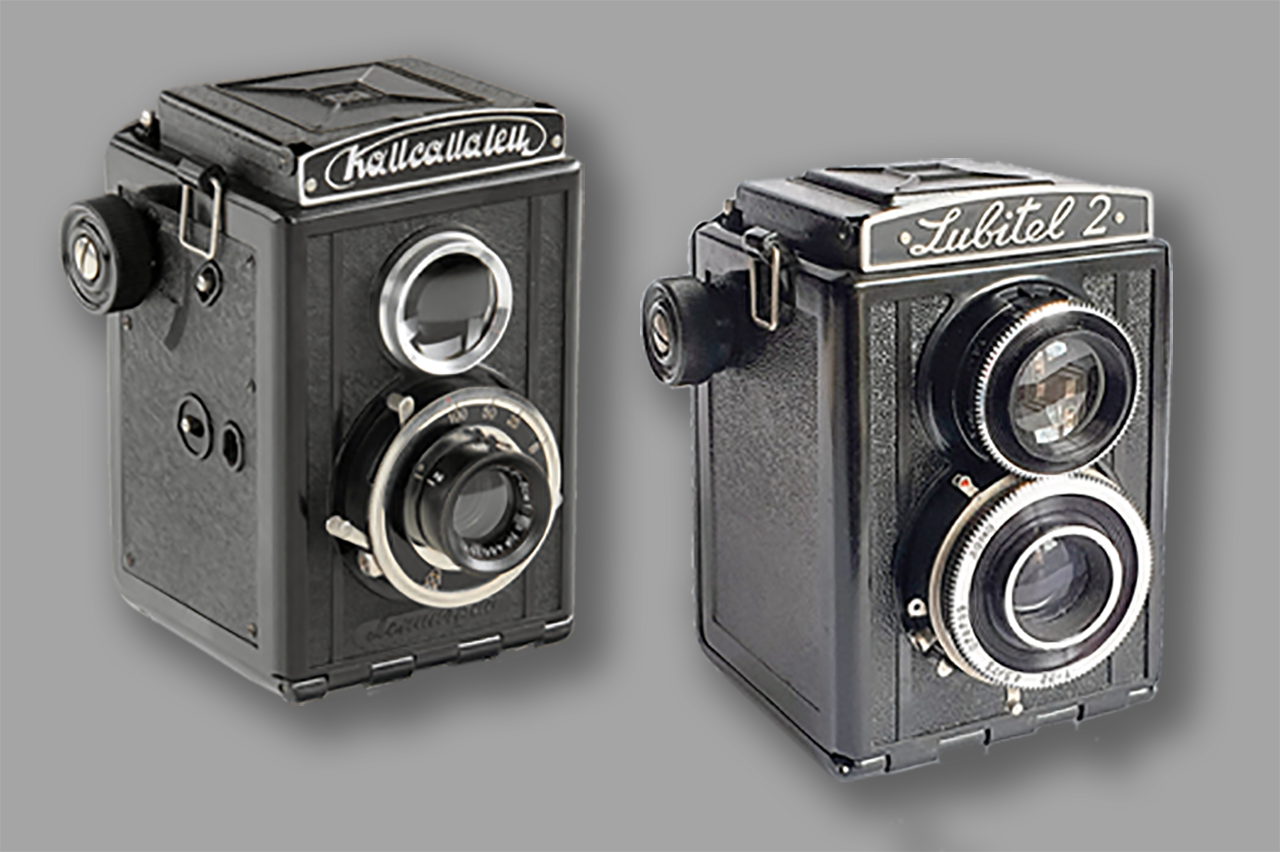
The Komsomolets and the Lubitel-2 together in a picture
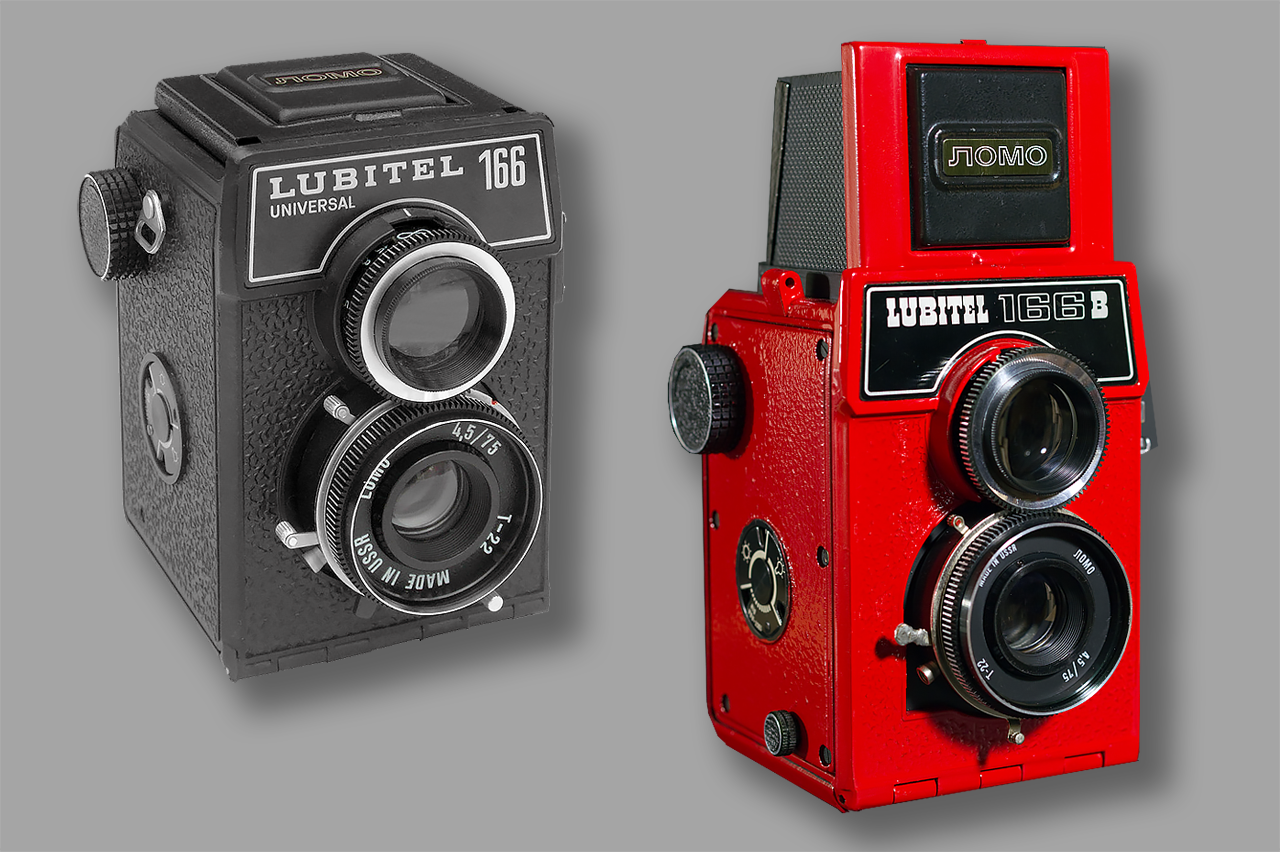
The Lubitel-166 and a special version of the Lubitel 166B together in a photo
Adopting the name from a member of the Communist youth organisation Komsomol, the Komsomolets focused at an amateur audience. The camera itself is a fairly straight copy of the non-focusing Voigtländer Brillant, although the design is simplified and altered somewhat. (For instance, the filter door doesn’t hinge like in the original.) The top and bottom lenses aren’t synchronised, even though Voigtländer already corrected that before the war in the Focusing Brillant.
The Komsomolets was designed by Ilya Grigoryevich Shapiro and manufactured from 1946 to 1951 in a quantity of 306.743 items (according to LOMO). The Komsomolets’ body was made of bakelite. Its shutter was a ZT with speeds of B, 1/25 s, 1/50 s and 1/100 s; the viewing lens was a 75mm f/4.5, while the taking lens was a T-21 (Triplet) 80mm f/6.3.
It seems that exists a model A and a model B Komsomolets. The model A is sometimes marked “Model A” on the viewfinder hood, and is distinguishable from the Model B by its mechanical frame counter, as opposed to the red window in the B model.
Some of the later B models are said to have T-22 75mm f/6.3 lenses, which probably resemble the T-22 75mm f/4.5 lenses on the later Lubitels.
Gradually or not, in 1949 the Lubitel saw the photographic light. According to LOMO, this camera was produced from 1949 to 1956 in a quantity of 1.361.110. It’s best seen as a mature Komsomolets: it added focusing capability by means of an interlink between the viewing and taking lenses, its ZT-5 shutter had a larger range of shutter speeds than the Komsomolets (B, 1/10 s-1/200 s), its viewing lens was a speedy 60 mm f/2.8, and its taking lens a T-22 75 mm f/4.5, both faster and more wide angular than the lenses on the Komsomolets. Lubitel means “Amateur”. Incidentally there’s a version of the Lubitel labelled “Amatör” for the East German market.
After the production of one million three hundred thousand Lubitels, GOMZ re-evaluated the design and decided to add a self-timer and a flash sync. This redesign was done by G. Barkovski, thus creating the Lubitel-2. The literature claims that the Lubitel-2 was manufactured with two different shutters: a ZT-5 with speeds of 1/10 s to 1/200 s, and a ZT-8 with 1/15 s to 1/250 s.
Another difference, but subtler, is the changing profile of the Bakelite. Each time the body moulds wore out, they repaired the existing or created new ones with new random leather textures. These variations in structure could conceivably be used as forensic data to date and group cameras.
Other changes include the mould for the filter door: on older cameras it’s engraved in Russian only, but newer cameras have bi-lingual English/Russian markings. Also, the winding knob is clearly manufactured from different moulds throughout the Lubitel’s life. The design of the spring plate to hold the lower film roll also differs between cameras. A very obvious difference between GOMZ and LOMO Lubitels is the presence of the GOMZ logo in the hood; this dates the camera before 1965; in that year GOMZ became LOMO.
The Lubitel-2 was manufactured from 1955 to 1980 in a quantity of 2.232.245 (again factory data). It was superseded in 1976 by the Lubitel-166 (and later the 166B and -U), which shares its concept with the Lubitel-2 (cheap 6 x 6 TLR) but is really a whole different camera. The Lubitel-2 was marketed under a variety of brands. The most common is the plain Lubitel-2, either with Latin or Cyrillic script, but one can also find the Kalimar TLR100, the Global 676, and possibly other variants for different markets.
In 1953, Ilya Grigoryevich Shapiro would once again release an inexpensive Bakelite 35mm camera using the name Smena, but this time, it was an all new design. Why was the name “Smena” used once again for an entirely different camera? On his site sovietcams.com, author Aidas Pikiotas hypothesizes that the release of the new Smena coincides with the death of Joseph Stalin and could have been seen as a “Change” in leadership, or it could have just been a coincidence. Whether any of that is true or not, is anyone’s guess and we’ll likely never know.
Over the next few years, the Smena would be continuously updated with additional features such as flash synchronization, a self timer, improved film advance levers, and improved shutters. An unofficial “first generation” of Smena cameras would last through the Smena-4 before being replaced by the all new Smena-5.
In 1962, the GOMZ factory would be reorganized as the Leningrad Optical and Mechanical Association of Enterprises, or LOMO for short, which is the name it still uses today. This association included several other, smaller plants.
In the decades that would follow, a huge number of Smena branded cameras along with Smena variants such as the Vesna and Zenit-35F would be released. Although the look and design of the Smena series would constantly evolve, a common entry level feature set would remain. It is estimated that in total, over 30 million cameras were produced with the name “Smena” throughout it’s production run making it one of the most successful marques in the camera industry.
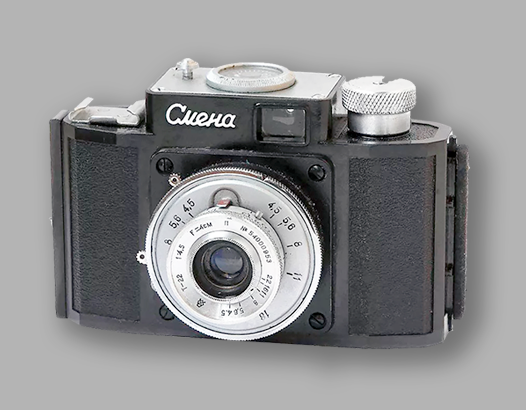
Smena cameras were not just very popular, but literally super-popular in USSR. Almost every family in the Soviet Union had such or a similar camera. Most of the home archives were created using Smena cameras, and novice photographers took their first steps in photography with this soviet camera in their hands. This 35mm viewfinder Smena was manufactured at the GOMZ plant from 1953 to 1962. It made 24x36mm images on 135 film.
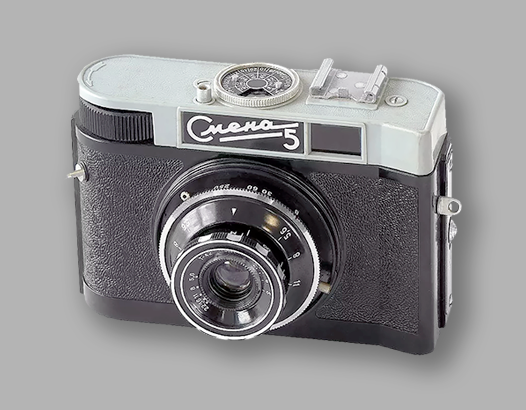
The Soviet photographic industry loved to simplify and cheapen everything that could be simplified and cheapened. A vivid example of this is the Smena-5 camera. This camera came after the innovative (by Soviet standards) Smena 4 camera. The Smena-5 is a viewfinder 35mm film camera, produced between 1961-62.
It so happened that due to the peculiar system of organization of production in the USSR, different plants occupied strictly defined market positions.
- Kiev factories created high-quality (by Soviet standards) products for professional photographers.
- The KMZ plant mainly produced middle-class cameras for advanced enthusiasts (for example, Zorki and Zenit cameras).
- And the LOMO plant was considered a manufacturer of simpler products for the most inexperienced photographers or schoolchildren.
But despite this, the cameras produced at the LOMO plant were not so bad. For example, the Smena cameras allowed absolutely everyone to get acquainted with photography because the price of these cameras were very low. Smena cameras were not just very popular, but literally super-popular in USSR. Almost every family in the Soviet Union had such or a similar camera. Most of the home archives were created using Smena cameras, and novice photographers took their first steps in photography with this soviet camera in their hands.
LOMO produced also Lubitel cameras, which were the only medium-format twin-lens cameras in the USSR. Despite their low price, these cameras also gave excellent image quality, and in fact, to this day are the most affordable way to start taking medium format photographs.
LOMO created a lot of archetypical and interesting cameras over the years. LOMO-graphy was a welcome break to LOMO in the Russian depression of the mid-1990’s. Nowadays LOMO seems to have left all camera production behind (with perhaps the exception of the LC-A), and is focusing on scientific and industrial grade optics.

Camera ListinGS
- Alma
- Electra-122
- Fotocor
- Junost
- Komsomolets
- Leningrad
- Liliput
- Lomo
- Lomo LC-A
- Lubitel
- Lubitel 2
- Malutka
- Moment (instant)
- Reporter
- Smena
- Sokol-2
- Sokol Automat
- Sputnik
- Sport
- Turist
- Voskhod
- Zenit-35F
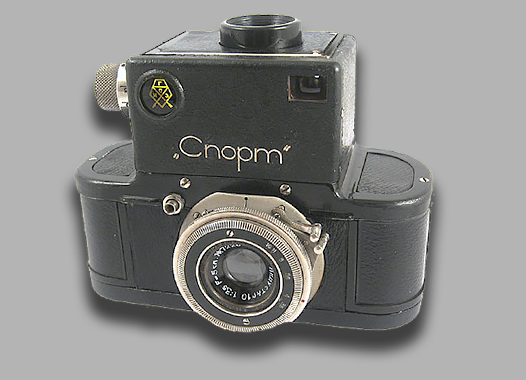
Sport is a Soviet SLR camera, designed for 35 mm film. It is considered one of the world’s first small-format cameras of this type. An experimental batch of Sport cameras was released in 1934. Serial production was launched at the GOMZ plant in Leningrad and lasted from 1937 to 1941. Over the entire production period, about 19000 copies of the Sport camera were released.
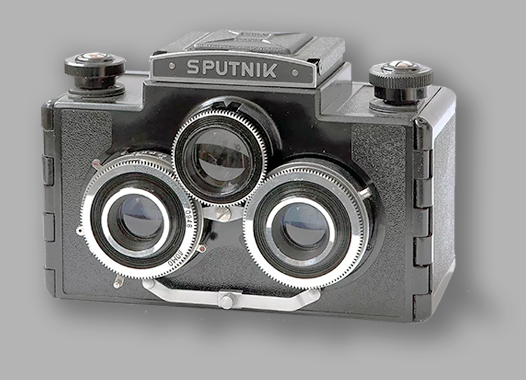
Sputnik is a stereo camera manufactured by LOMO from 1955 to 1973. In fact, Sputnik was a TLR camera with two shooting lenses. More precisely, it was a redesigned Lubitel TLR. This camera took two photos at a time. If you look at these photos through a stereoscope, you can see the effect of a three-dimensional image. The camera is designed for amateur and professional stereoscopic photography on black-and-white and color 120 film. Like the original Lubitel cameras, this camera has a frame size of 6x6cm. And just like the original TLR, the Sputnik camera was made of fairly high-quality plastic.
COMPANY NAMES:
1887: Folmer and Schwing Manufacturing Company of New York, NY; 1905: Folmer & Schwing Co. Rochester, NY; 1909: Folmer & Schwing Division of Eastman Kodak Company Rochester, NY; 1928: Folmer Graflex Corporation Rochester, NY; 1946: Graflex Inc. Rochester, NY; 1956: Graflex Inc., Division of the General Precision Instrument Company Rochester, NY; 1968: Graflex Inc., Division of Singer Corporation; 1973: it dissolved and its tooling sold to the Toyo Corporation.
COMPANY ADDRESS:
1887: New York City; 1909: 12 Caledonia Avenue (later renamed Clarissa Street), Rochester, NY; 1956: 3750 Monroe Avenue, Pittsford, NY.
Graflex was an American camera manufacturer based in Rochester known for its press cameras, and large format SLRs. Graflex produced a variety of camera products for a wide variety of formats over the company’s 80-year history.
It had the enviable position of being the industry standard for press photographers for largely six decades. For a little over half a century, Graflex and Graphic cameras captured the newsworthy and memorable pictures of history. Likewise, no other camera builder has as many Pulitzer Prizes associated with its cameras.
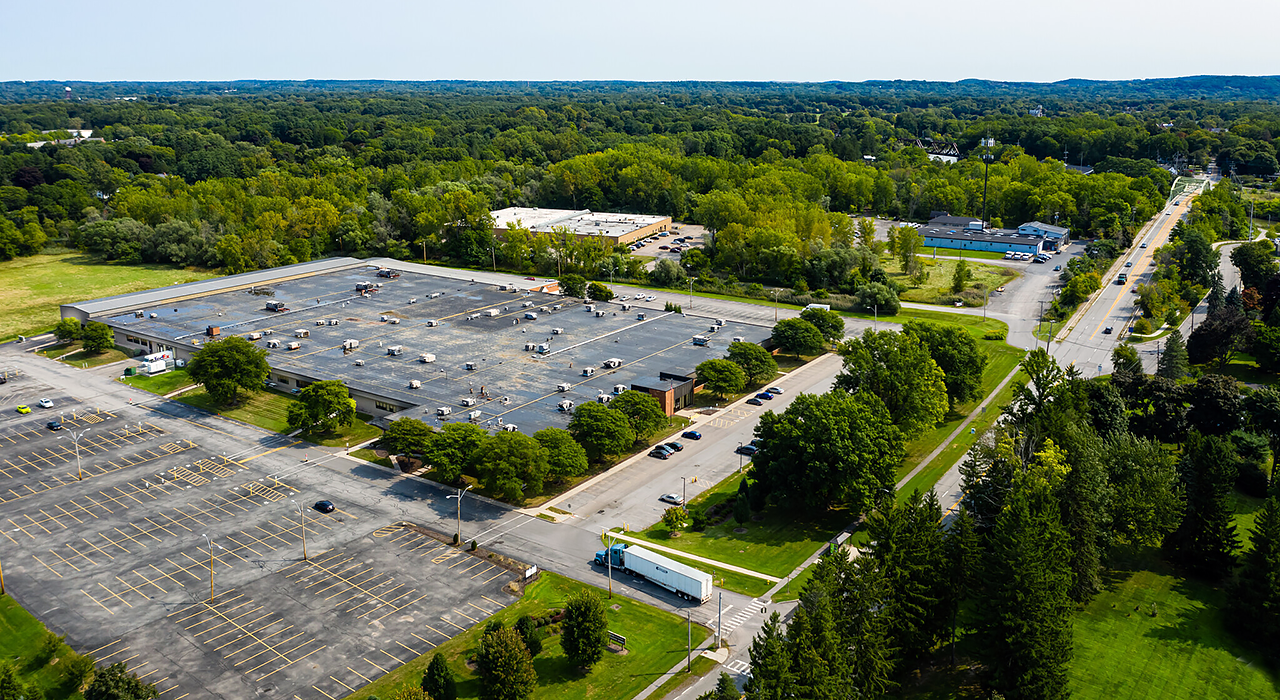
The Graflex plant in suburban Pittsford, New York still stands at 3750 Monroe Avenue, and was the corporate headquarters of Veramark Technologies Pittsford, New York from 1997 to 2010.
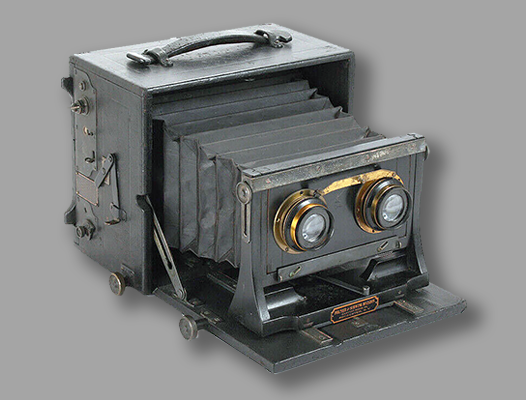
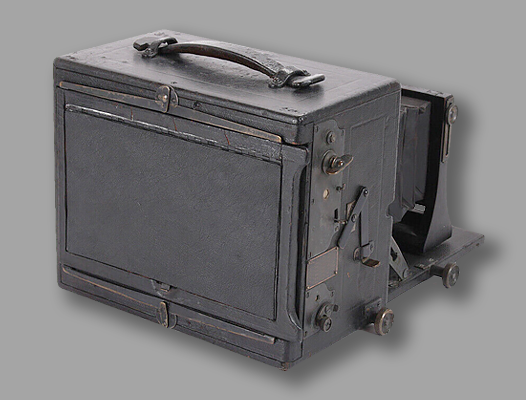
The Stereo Graflex was manufactured by the Folmer & Schwing Co. from approximately 1904 to 1905. At this time it was the only American made reflecting stereo camera. This camera took two identical pictures on a 5 x 7 glass plate. It was fitted with a Graflex multi-slit focal plane shutter providing speeds from 1/5th to 1/1000th of a second. It front bellows extended via rack and pinion for focusing. There were tow prisms in the hood at the top of the box that makes it a stereoscope when viewing the image and the image is right-side up in full view. When closed the camera measures 8 1/4 x 9 x 8 3/4 inches.
The company was founded as the Folmer and Schwing Manufacturing Company in New York City in 1887 by William F. Folmer and William E. Schwing as a metal working factory, manufacturing gas light fixtures and chandeliers. As the gas lamp market declined, the company expanded into other areas including bicycles and photographic equipment, later focusing on cameras exclusively; after introducing their first focal plane Graflex camera in 1899.
With the success of their focal plane cameras, the company chose to focus on photography and dropped its other manufacturing lines. The Stereo Graflex was manufactured by the Folmer & Schwing Co. from approximately 1904 to 1905. At this time it was the only American made reflecting stereo camera. This camera took two identical pictures on a 5 x 7 glass plate. It was fitted with a Graflex multi-slit focal plane shutter providing speeds from 1/5th to 1/1000th of a second. It front bellows extended via rack and pinion for focusing.
Folmer and Schwing would be bought out by George Eastman in 1905, and integrated into Kodak as the Folmer Graflex division of Eastman Kodak by 1907. The company was moved to 12 Caledonia Avenue (later renamed Clarissa Street), Rochester, NY, where Eastman Kodak made all of the Graflex cameras. The Rochester Folmer plant also manufactured the Century Studio Camera, which was marketed under both the Kodak and Graflex nameplates. However, because Graflex printed separate catalogs for its studio and portable offerings, many erroneously believe the Century Studios to have been manufactured elsewhere.
Graflex had to leave Kodak
Eastman Kodak made all of the Graflex cameras in their professional equipment manufacturing plant on Clarrisa street in Rochester NY. By 1921, Kodak had become a camera manufacturing monopoly in the United States, and was forced to divest itself of several assets including Folmer Graflex, as a result of violations of the Sherman Anti-Trust Act (Comp. St. § 8820 et seq.).
Failing to find a buyer for its professional equipment division, the company was spun off as Folmer Graflex Corporation in 1928.
In 1946 it was renamed to Graflex Inc. The company existed under independent ownership until 1958, when the company was bought by the General Precision Equipment, which operated it as an independent division until 1968, when it was sold to the Singer Corporation, who also operated it as a division until 1973 when it was finally wrapped up and its tooling sold to the Toyo Corporation.
Further Graflex history
In the 1950’s, Graflex would buy out the tooling and design of the Ciro 35 and Ciro-flex, renaming them the Graphic 35, and Graflex 22 respectively. The Ciro 35 started out as the Cee-ay 35 in 1949. It made images on 35mm film, had a non interchangeable lens, diaphragm shutter, and a coupled rangefinder.
The rangefinder was the split image type and was coupled to the lens, but was used through a separate viewfinder than that used to compose the image. Only eight months after its original introduction by Perfex as the Cee-ay 35, Ciro (makers of the CiroFlex TLR) bought the design, and after some very slight changes, it was reintroduced as the Ciro 35. Of course, the story doesn’t end there – soon Ciro sold out to Graflex, and the camera became the Graflex Ciro 35.
After Ciro was bought out by Graflex in the early 50s, production of the Ciroflex 120 format TLR continued as the Graflex 22. The Graflex 22 is medium format TLR camera that makes 6x6cm images on 120 roll film. There is no double exposure prevention system. Graflex continued to produce cameras bearing the Ciro name until 1955.
From the depression of the 1930s to 1957 the company grew from 100 to 760 employees, and expanded to having a western branch in Los Angeles California.
In 1976 Cambo purchased the complete tooling, know-how and production of the Graflex XL camera from Singer Educational Systems, and marketed a slightly updated version as the Cambo XL for a time. Rights to the 4×5 Speed Graphic and Crown Graphic were bought by the Japanese manufacturer of Toyo view cameras around the same time.
The Graflex plant in suburban Pittsford, New York still stands at 3750 Monroe Avenue, and was the corporate headquarters of Veramark Technologies Pittsford, New York from 1997 to 2010.
Camera production
The first of the Graflex-branded cameras, released in 1898, was the Graflex camera, also known as the Graflex Reflex, or Graflex single lens reflex (SLR). This camera used the same swinging-mirror, through-the-lens viewing mechanism as modern single lens reflex cameras, introduced many decades later, and quickly became popular for sports and press photography in the early 20th century due largely to its use of a focal plane shutter.
To produce shutter speeds fast enough to appear to freeze rapid motion, early Graflex cameras employed a cloth shutter with a narrow slit that quickly moved across the film plane, exposing only one small strip at any given moment in its travel.
The Graflex Reflex was also popular among early 20th Century fine art photographers, leading several lens manufacturers to design special soft-focus lenses, including the famous Wollensak’s Verito, to support the camera’s creative potential.
From 1912 to 1973 Graflex produced large format and medium format press cameras in film formats from 2+1⁄4 by 3+1⁄4 inches (57 mm × 83 mm) to 4 by 5 inches (100 mm × 130 mm) . They also produced rangefinder, SLR and TLR cameras in a variety of formats ranging from 35mm to 5 by 7 inches (130 mm × 180 mm).
The Crown Graphic models of this same period were similar in overall design to the Speed Graphics, but omitted their focal plane shutter, allowing Crown Graphic models to be about one inch (2.5 cm) smaller and 1 pound lighter (.5 kg) Furthermore, their lack of a focal plane shutter allowed lenses to be mounted closer to the film plane, enabling the use of wider angle lenses on these models.
The Rochester Folmer plant also manufactured the Century Studio Camera, which was marketed under both the Kodak and Graflex nameplates. However, because Graflex printed separate catalogs for its studio and portable offerings, many erroneously believe the Century Studios to have been manufactured elsewhere.
In the late 1920’s and early 30’s Graflex would simplify its product lineup, and redesign its press cameras to take advantage of new technology like flashbulbs. It would introduce the National Graflex in 1933, it’s first attempt at a mass market camera.
In 1940, Graflex introduced its anniversary Graphics, refreshing the styling and mechanics to better take advantage of flash equipment and synchronized shutters. In 1948 it introduced the Graflex Super D, the first Graflex SLR with flash synchronization from the factory.
In 1965, the company introduced the Graflex XL, based on the same concept as the Mamiya Press and Linhof Technika Press. By the 1970’s, much of the consumer camera products had been discontinued due to Japanese imports, and with the shift towards 35mm and 120 SLR’s in the professional market, Graflex’s historical professional customer base had largely eroded.
Cameras from Graflex and its predecessor Folmer & Schwing
- 1912–1973 Speed Graphic Models
- 1912–1927 Top Handle Speed Graphic
- 1928–1939 Pre-Anniversary Speed Graphic
- 1939–1946 Miniature Speed Graphic
- 1940–1946 Anniversary Speed Graphic
- 1947–1970 Pacemaker Speed Graphic
- 1947–1973 Pacemaker Crown Graphic
- 1949–1970 Century Graphic
- 1958–1973 Super Graphic
- 1961–1970 Super Speed Graphic
- 1940–1943 Graflex C-3
- 1942–1944 Graflex PH-47-F
- 1942–1944 Graflex PH-47-E
- 1947–1949 Graflex PH-47-H
- 1947–1950 Graflex C-6
- 1949–1952 Graflex PH-47-J
- 1953–1957 Graflex KE-4
- 1953–1955 Graflex KE-12
- 1965–1973 Graflex XLRF KS-98B
35mm rangefinder and stereo
- 1949–1953 Graflex Ciro 35
- 1955–1962 Graflex Stereo Graphic
- 1955–1957 Graflex Graphic 35
- 1957–1961 Graflex Century 35
- 1959–1963 Graphic 35 Electric (also known as Iloca Electric)
Other large format and SLR cameras
- 1907–1923 Press Graflex – 5 by 7 inches (130 mm × 180 mm)
- 1909–1941 Auto Graflex
- 1923–1952 R.B.Graflex Series B (R.B. for Rotating Back)
- 1938–1942 Crown View
- 1941–1949 Graphic View
- 1949–1967 Graphic View II
- 1912–1940 5×7 Home Portrait Graflex
- 1923–1932 5×7 Series B Graflex
- 5×7, 3×5 Compact Graflex
- 5×7 Stereo Graflex
- 1928–1947 3×4 and 4×5 Series D
- 1941–1963 Super D Graflex
- 3×4 Series C Graflex with Cooke 2.5 Lens
- 3×4 and 4×5 RB Auto Graflex
- 4×5 Naturalist Graflex
- 1933–1941 National Graflex Series I, Series II
- 1952–1956 Graflex 22
- 1965–1973 Graflex XL
- 1953–1957 Combat Graphic
- 1971–1976 Graflex Norita (also known as Norita 66)
- 1941–1945 Folmer Graflex K-20 Aircraft Camera (also known as Fairchild K-20)
- Folmer Graflex K-21 Aircraft Camera
- Folmer Graflex K-25 Aircraft Camera
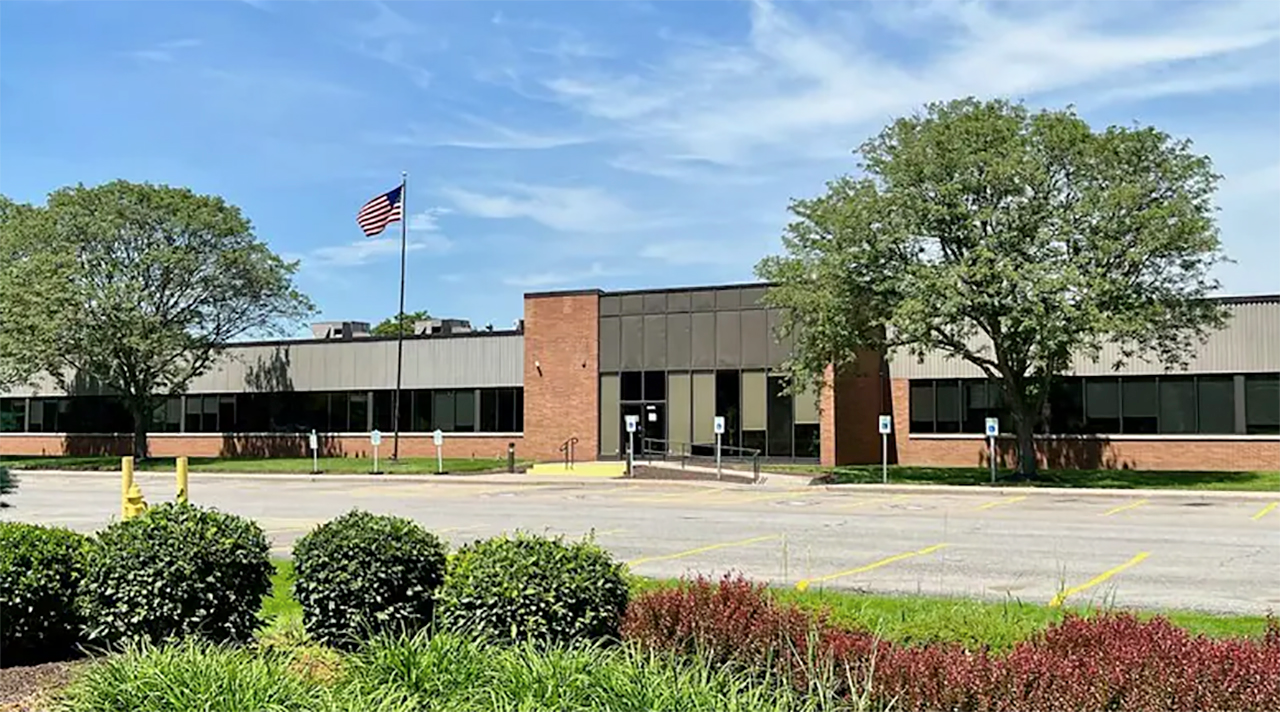
Former Graflex Plant, 3750 Monroe Avenue, Pittsford, New-York.
The Press Graflex was a 5×7″ SLR. Designed specifically for the work associated with daily news papers and illustrated magazines. It was robustly constructed to ensure alignment to adjustments and withstand day to day use.
It got a special focal plane shutter which had speeds from 1/5 sec. up to 1/1500 sec. with narrow curtain slit or slower speeds with wider curtain slit. This was faster and less complicated than the focal plane shutters of the regular Graflex reflex cameras which were slower and had more slits.
Aircraft
Graflex K-20 is a hand-held large format aerial photography camera designed by “Fairchild Camera and Instrument”, used during World War II by the U.S. Army, with Paragon Anastigmat 4.5/163mm lens and red filter.
Approximately 15,000 were manufactured under licence for military contract between 1941 and 1945. The K-20 uses a large–format 5.25″×20′ to 5.25″×200′ roll film, with an image size of 4×5 inches. The camera featured the use of a vacuum to keep the film flat.
The Graflex Ciro 35 started out as the Cee-ay 35 in 1949. It made images on 35mm film, had a non interchangeable lens, diaphragm shutter, and a coupled rangefinder. The rangefinder was the split image type and was coupled to the lens, but was used through a separate viewfinder than that used to compose the image. Only eight months after its original introduction by Perfex as the Cee-ay 35, Ciro (makers of the CiroFlex TLR) bought the design, and after some very slight changes, it was reintroduced as the Ciro 35. Of course, the story doesn’t end there – soon Ciro sold out to Graflex, and the camera became the Graflex Ciro 35.
After Ciro was bought out by Graflex in the early 50s, production of the Ciroflex 120 format TLR continued as the Graflex 22. The Graflex 22 is medium format TLR camera that makes 6x6cm images on 120 roll film.
There is no double exposure prevention system. Graflex continued to produce cameras bearing the Ciro name until 1955.
FOUNDER: UNKNOWN
COMPANY NAME:
1955: Great Wall Plastic Co.
COMPANY ADDRESS:
Hong Kong’s Kowloon City.
Hong Kong began to manufacture a wide variety of plastic toys for export after the Second World War, boosted by the United States’ embargo of China. In the early 1960s, one factory, the Great Wall Plastic Company, decided to get an edge on its competitors by adding something new to its line-up of products: a toy camera. Quality was not a priority in the design or manufacture of their cameras.
During the 1960’s and 70’s there were several companies manufacturing cameras and binoculars in Hong Kong. Perhaps the most well-known was W. Haking Enterprises, founded by Dr Hanking Wong and Dr Paulina Chan who combined their names to form the brand name Halina. Several of these cameras can be seen in the Hong Kong Museum of History.
This time was a sort of “golden age” for the country’s plastic industry. Great Wall was one of those common, family-run factories, and it was not a precise or high-tech optical plant. In addition to the Great Wall factory, there was at least one other company in Macau that produced Dianas and Diana clones. There may have been more but it’s hard to know exactly how many.
Meanwhile, other plastics manufacturers had their eye on the Diana’s popularity, and cheap cameras boomed. Nestle released a cow-shaped novelty camera to promote its yoghurt. In 1971, Americans could exchange three tin labels and US$4.95 for a bright blue camera shaped like a tuna.
Two decades later, the Lomography movement stumbled on the camera and found it of equivalent optical distortion to the Russian LCA camera they favored for experimental photography. The Diana began to be manufactured again in 2007—although these days, the basic model sells for US$89, a 1025 per cent price increase from the 1960s—and its effects are memorialized through countless image-editing filters.
The number of different models and names of the Great Wall Factory’s cameras is staggering. Therefore we limit ourselves here to a short history of the company, a description of their Diana and Bedfordflex cameras and at the end an overview of the (all?) different cameras with a short description (courtesy of Sylvain Halgand’s site ‘Collection Appareils’ ).
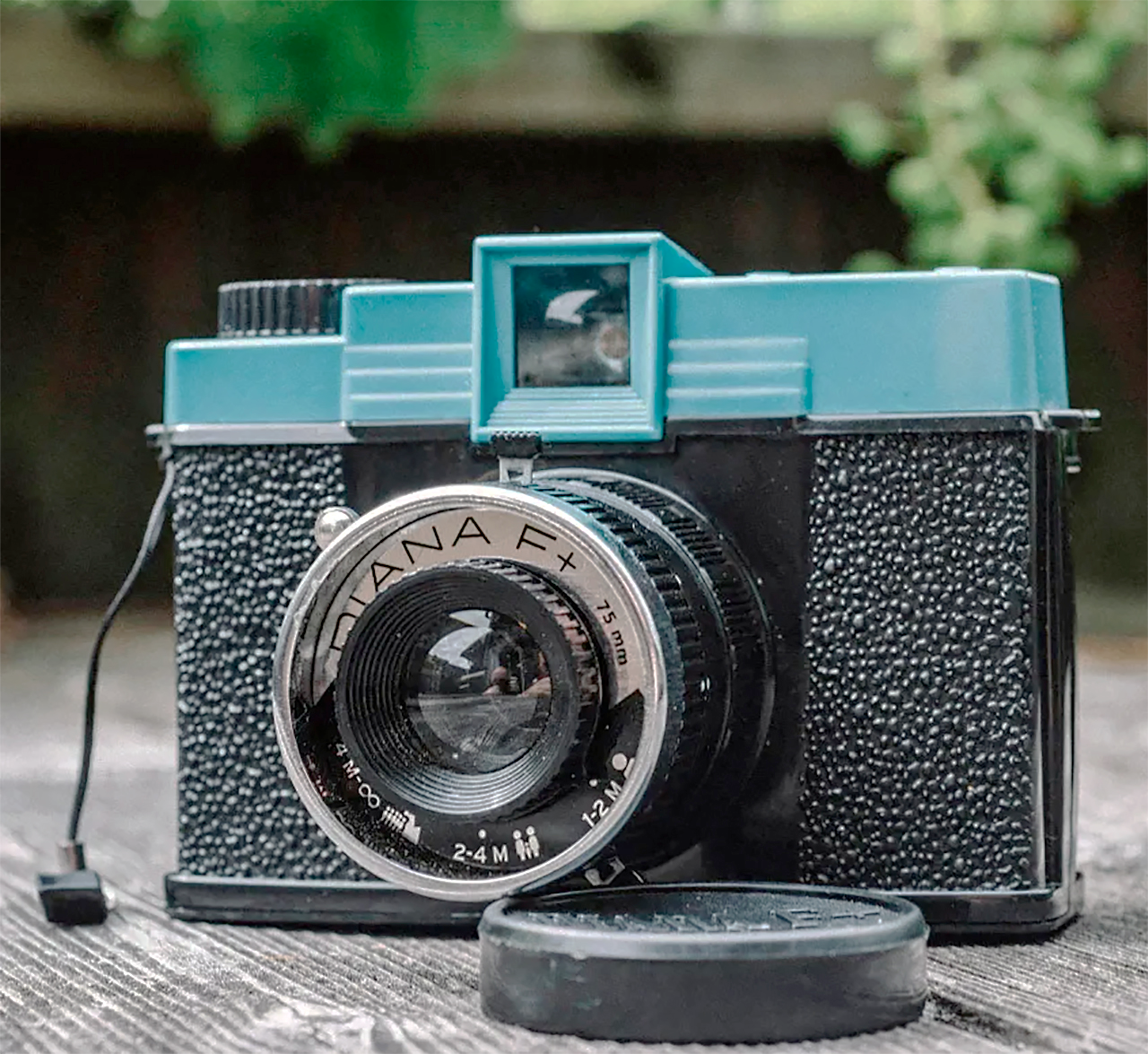
The Diana F+ is a simple and very light device. It’s all plastic. Its characteristics are similar to those of Diana. A lever makes it possible to select the exposure: sunny or cloudy, but it does not act on the diaphragm, which is fixed, but on the speed of the shutter which is approximately 1/50 or 1/60 and 1/ 100 seconds. Focusing is done by symbols on the lens ring: portrait, group, landscape.
The Diana Camera
According to a Hong Kong government catalog, the Diana was first introduced by the Great Wall Plastics Co. in the early 1960s. The factory was located in Hong Kong’s Kowloon City. Great Wall was a small factory. Only a few workers would have been required to produce a ton of Dianas. Most of the Hong Kong plastic factories at the time were small and family owned.
The Diana first appeared in the early 60s as a very inexpensive box camera. It had a plastic meniscus lens, two shutter speeds, three aperture settings, and could shoot 16 four-by-four frames on 120 film. The lens caused heavy vignetting, the focus was soft, and cracks in the shoddily fitting housing frequently leaked light onto the exposed film. Sometimes the film spool only advanced partially to the next frame, or stopped working entirely.
There was also the Diana F with a built-in flash. Essentially a toy it was made entirely of plastic including the lens. Quality control was lacking and they were considered to be primitive in the extreme. They had ill-fitting housing, images were often slightly blurred with vignetting and light leaks.
The majority were exported to the US and the UK. Hence, the cameras were produced with English writing, and the distance scale was printed in feet, not meters. The Diana was imported into the former by the ‘Power Sales Company’ of Willow Grove, Pennsylvania. In the 60s Power Sales Company wholesaled by the case, 144 cameras at about 50 US cents per camera. Even 50 years ago that was very cheap and most Diana cameras were given away or sold at nominal sums as novelties or prizes at fairs, product promotions or at raffles. For a time the camera was also regularly advertised for sale in periodicals through mail order vendors.
Eventually the Diana was eclipsed by the Kodak Instamatic — which didn’t require its users to wind the film, and didn’t blur and distort its subjects — and by the mid-1970s, manufacturing of Dianas had ceased. The total amount of Dianas produced is impossible to count. The production volume must have been huge!
The Bedfordflex TLR
The Bedfordflex seems to be a twin of the Hong Kong-made Jojaflex, Stellarflex, Wonderflex, Randorflex, Iloflex, Splendidflex and Roskoflex. All are marked “f8 speed 1/50 sec.,” have similar nameplates, and are billed as “double-lens reflex” cameras. But these are not true TLRs, as the lenses are fixed focus and the simple brilliant finder does not offer true reflex focusing.
Another very similar camera was the Ilfoflex, apparently used as a promotional gift by Ilford in 1961.. The Ilford Ilfoflex was a low cost plastic twin lens reflex style box camera, made in Hong Kong, by ‘The Great Wall of China Manufacturing Company’. Equipped with a fixed focus ‘Brytex’ f8 lens and a shutter with I(instantaneous) and B(bulb), the Ilfoflex took 12 pictures, 4×4 cm, on 127 roll film.
Bill Smith, who was Ilford’s Product Manager for cameras and accessory equipment and oversaw the sales of the Sportsman camera range and introduction of the Elmo cameras, recalls that the Ilfoflex was never sold in any quantity except in the promotional market – not via retailers. He remembers leaving an example on a sunny windowsill of his office while away on vacation. On his return it had transformed itself into abstract sculpture due to the heat of the sun coming through the window!
It is likely that the production of the Bedfordflex stopped in the 1970s together with the manufacture of the Diana camera.
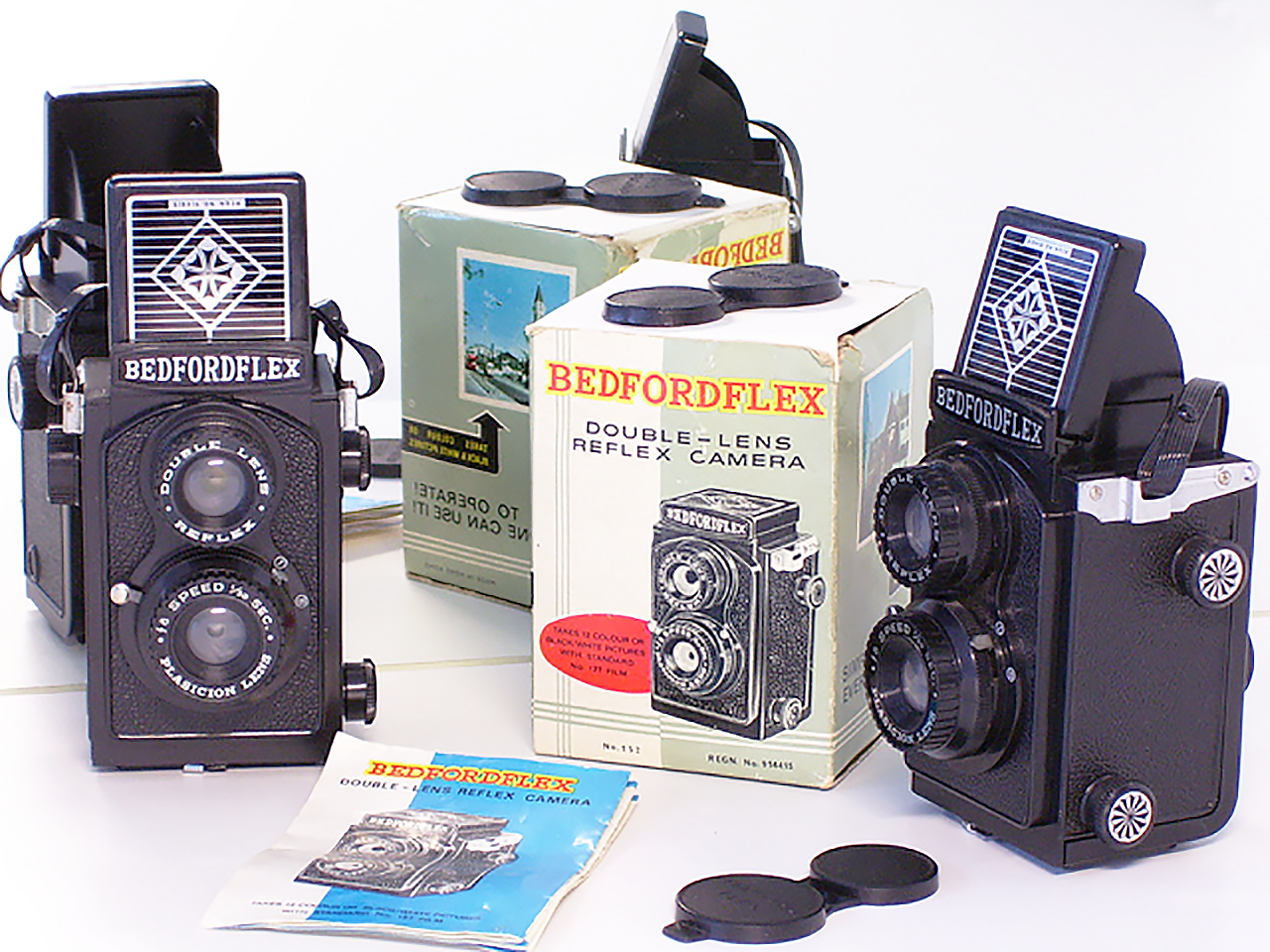
Below are (thanks to Sylvain Halgand) a dozen different(!?!) cameras. It seems almost certain that there are undoubtedly more made by the company with the same body but a different name, but this is a small selection from the range.
Manufactured or assembled in Hong Kong in 1965. The most famous of this production was the Diana, but the Great Wall Plastic Factory manufactured dozens of different models, and multiplied the number by simply changing the name of the models. These cameras can take photos, but are known to have light leaks, film frame issues, inaccurate shutter speeds, flare, and aberrations, resulting in unpredictable results. Note that the viewfinder is rectangular, while the negative is square.
Manufactured or assembled in Hong Kong in 1970. One thing is certain: it uses 127 film (it’s marked once on the camera and seven times on the box) and it was made in Hong Kong. It is a plastic box with a screen-printed sheet metal facade. It has a “diaphragm”, in the form of a plate with 2 holes of different diameters operated by a small lever, and a non-cocking single-speed shutter. The lens is a meniscus. Of course, the grid on the front which tries to imitate a selenium cell is a trompe l’oeil.
Manufactured or assembled in Hong Kong in 1950s. In the spirit of Diana, on this model, the parts that are not plastic can be counted on the fingers of one hand. We find this camera under several names: Jojaflex, Stellarflex, Wonderflex, Randorflex, Iloflex, Splendidflex and Roskoflex. All are marked “f8 speed 1/50 sec.,” have similar nameplates, and are billed as “double-lens reflex” cameras.
Manufactured or assembled in Hong-Kong in 1970. The Diana is a camera without a name or more exactly with a multitude of names. The accumulation of defects make it a cult object, especially in the USA, where some rush on anything that looks like a Diana to do “photography”. The Diana and its multiple avatars can also be collector’s items and fall into the “Toy camera” category. The Dianas were made in Hong Kong (then a British colony) or in Macao (Portuguese). Even if the shapes, names and colors change, the flaws remain.
Debonair
Manufactured or assembled in Hong Kong in 1970. It is a simple and very light device. It’s all plastic. Its characteristics are similar to those of Diana. A lever makes it possible to select the exposure: sunny or cloudy, but it does not act on the diaphragm, which is fixed, but on the speed of the shutter which is approximately 1/50 or 1/60 and 1/ 100 seconds. Focusing is done by symbols on the lens ring: portrait, group, landscape.
Manufactured or assembled in Hong Kong in 1970. Halfway between a toy and a camera, the Clik-O Mat is a nice plastic parallelepiped with the front face decorated with a screen-printed metal plate. This small camera, which uses 126 film cartridges, accepts the latter reconstituted with 135 mm film without hindrances or blockages because it has a small button allowing to release the perforations of the film to pass the following frame.






